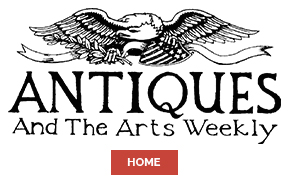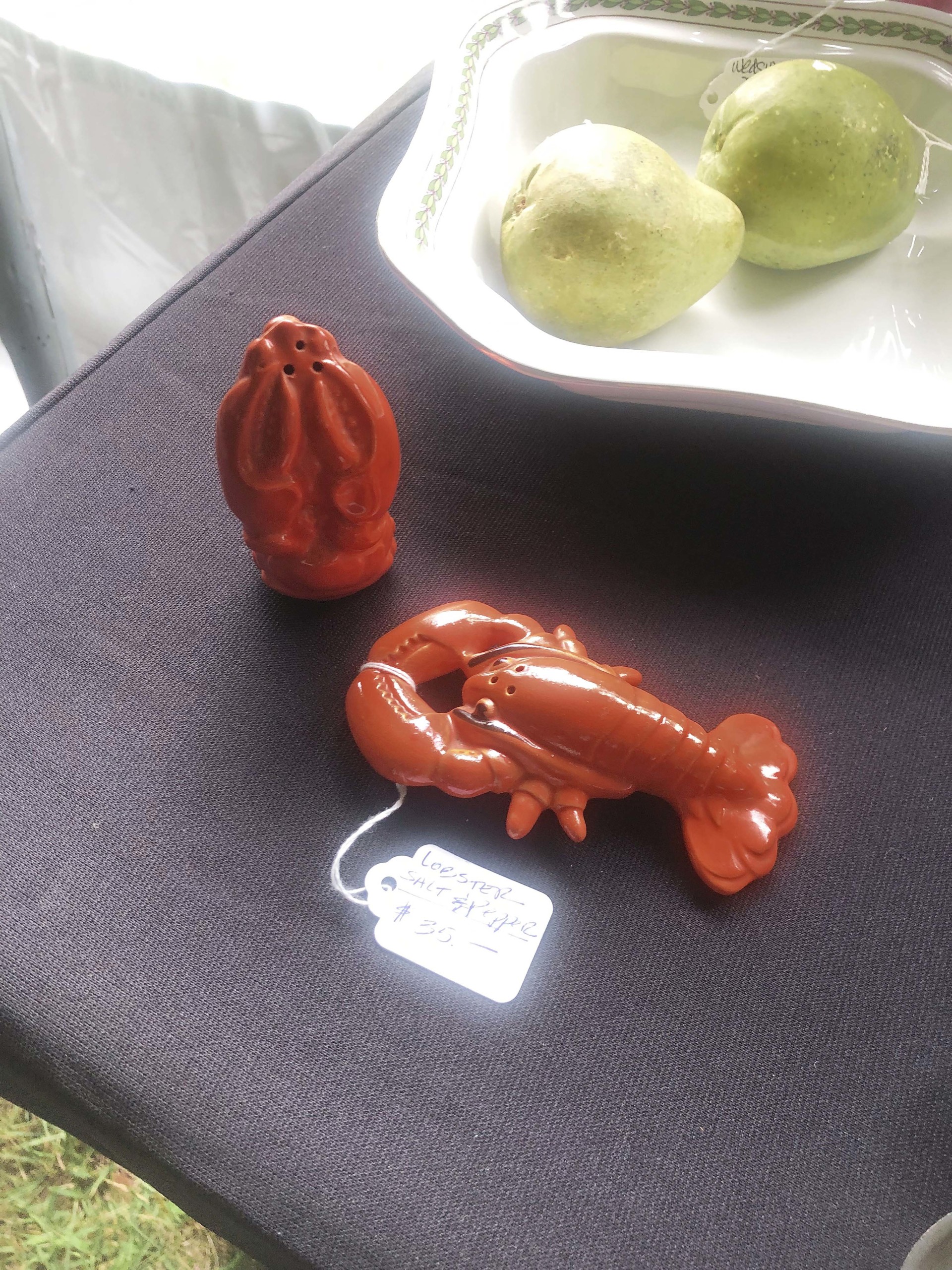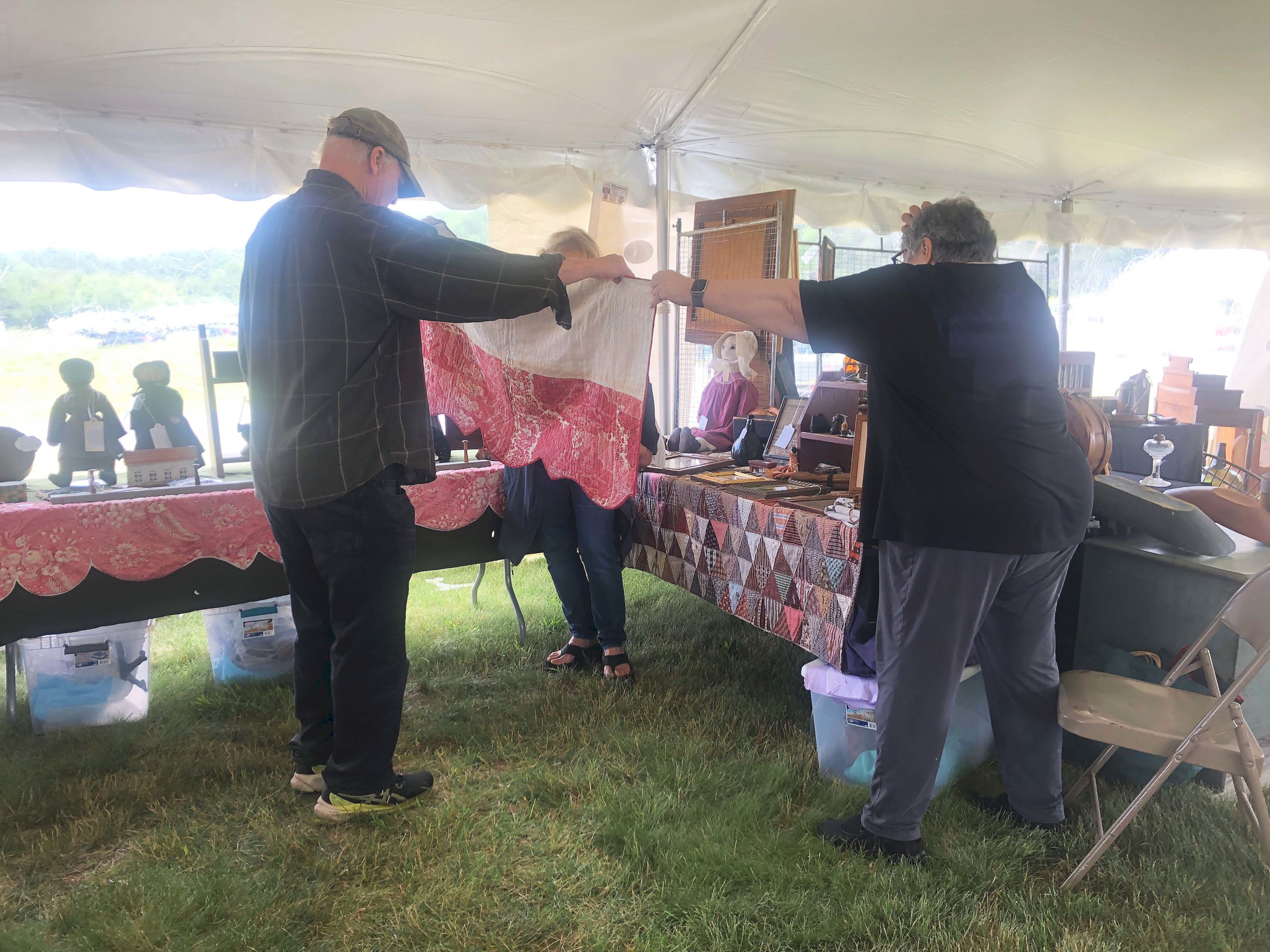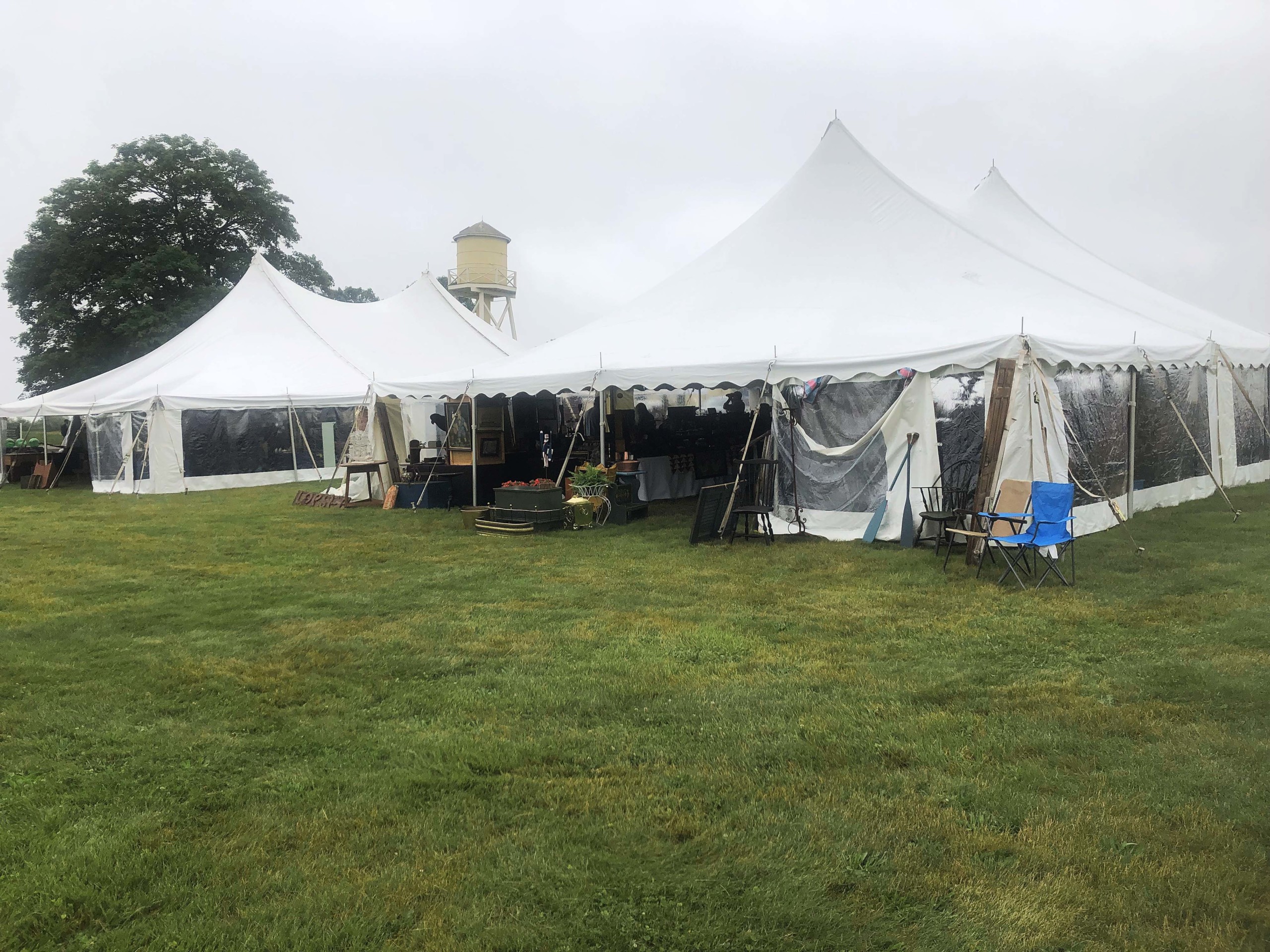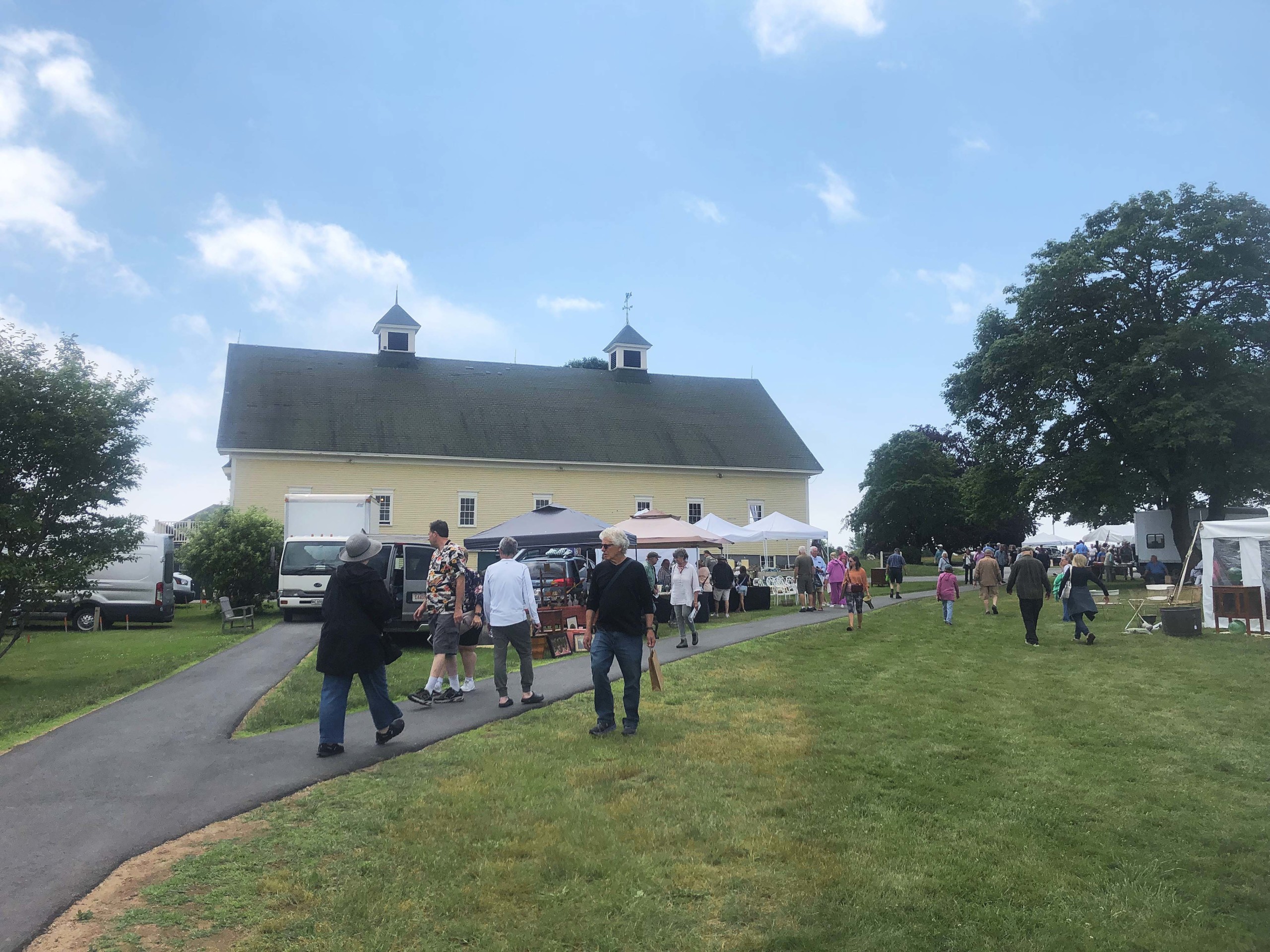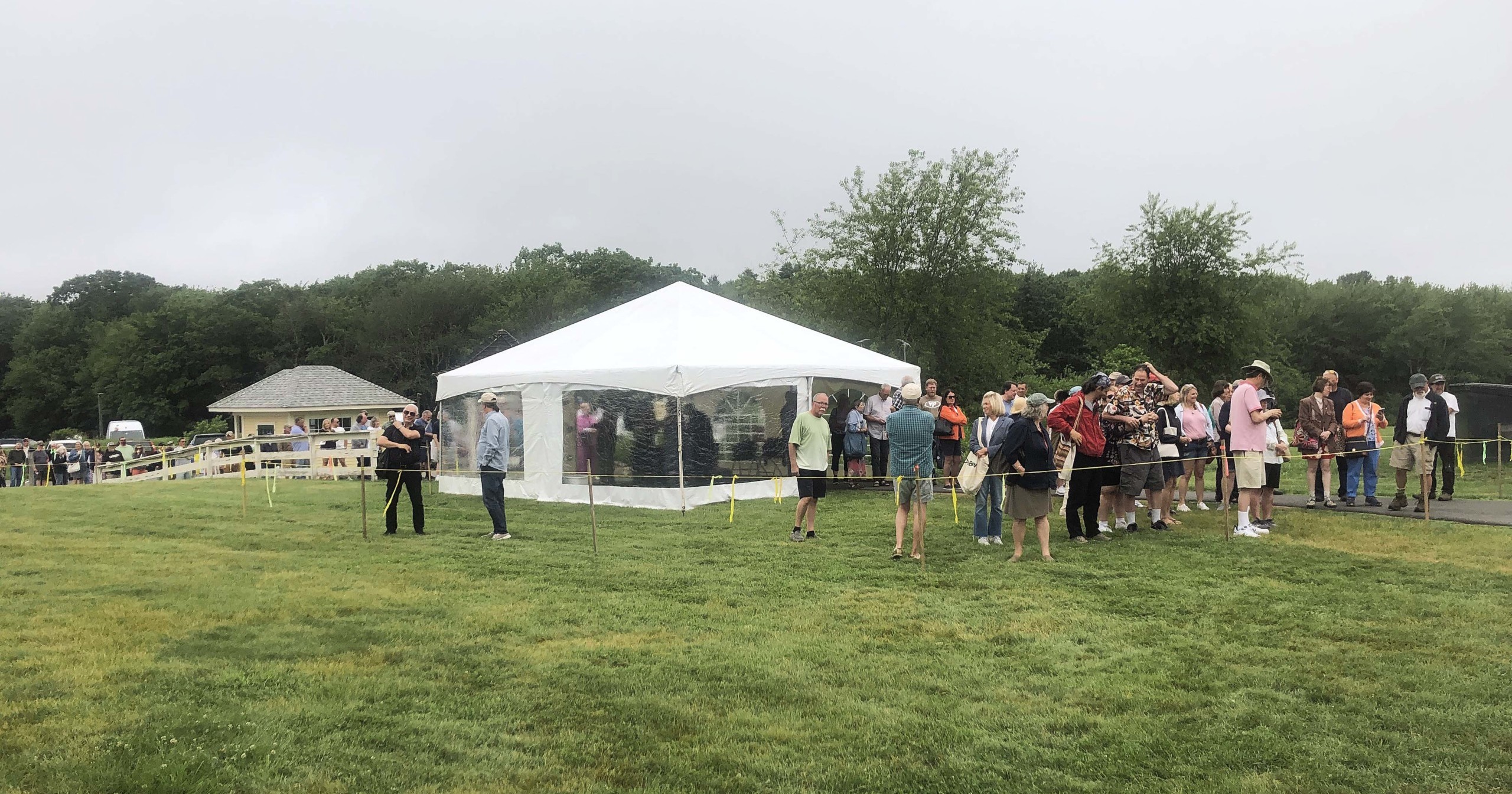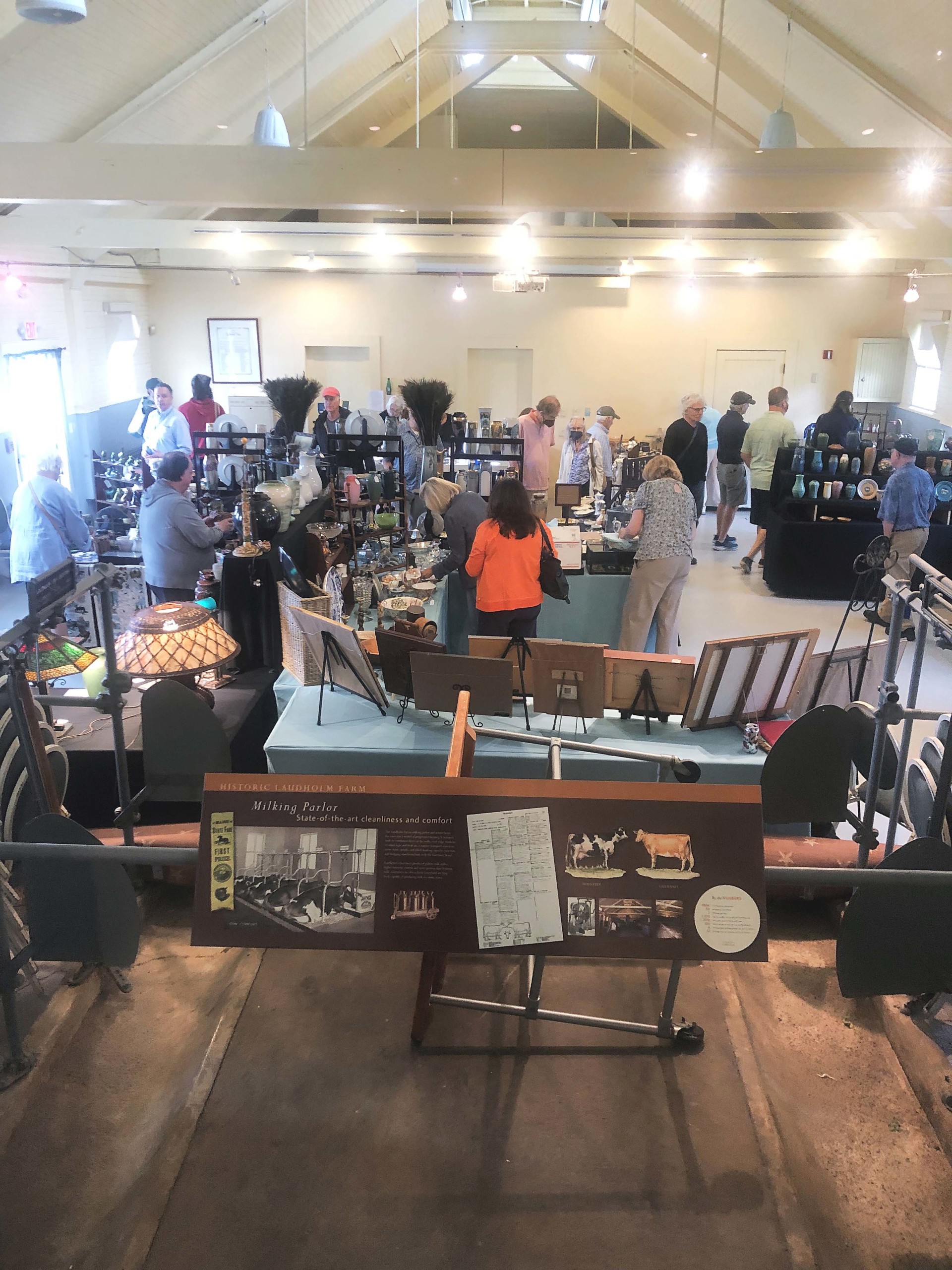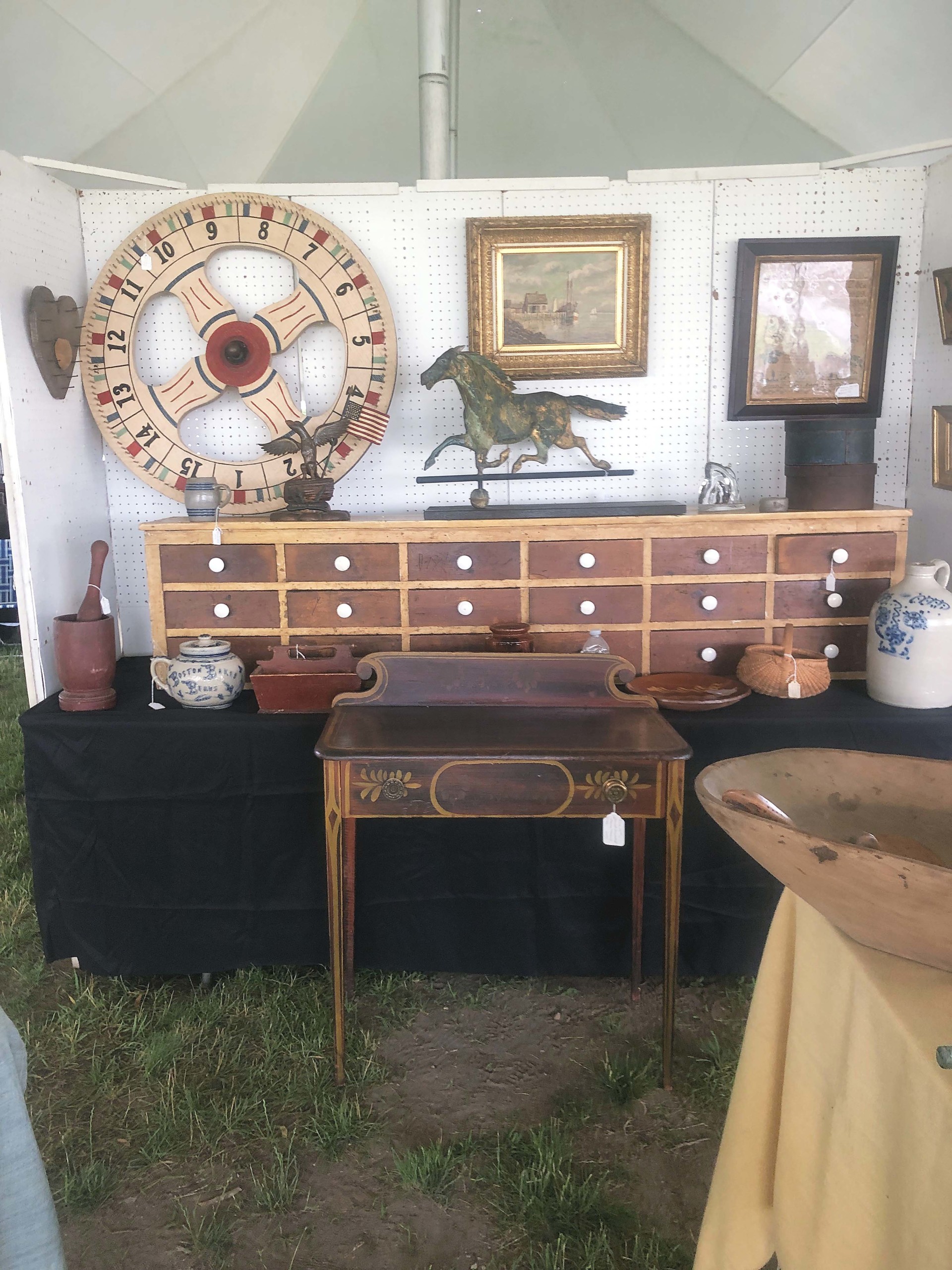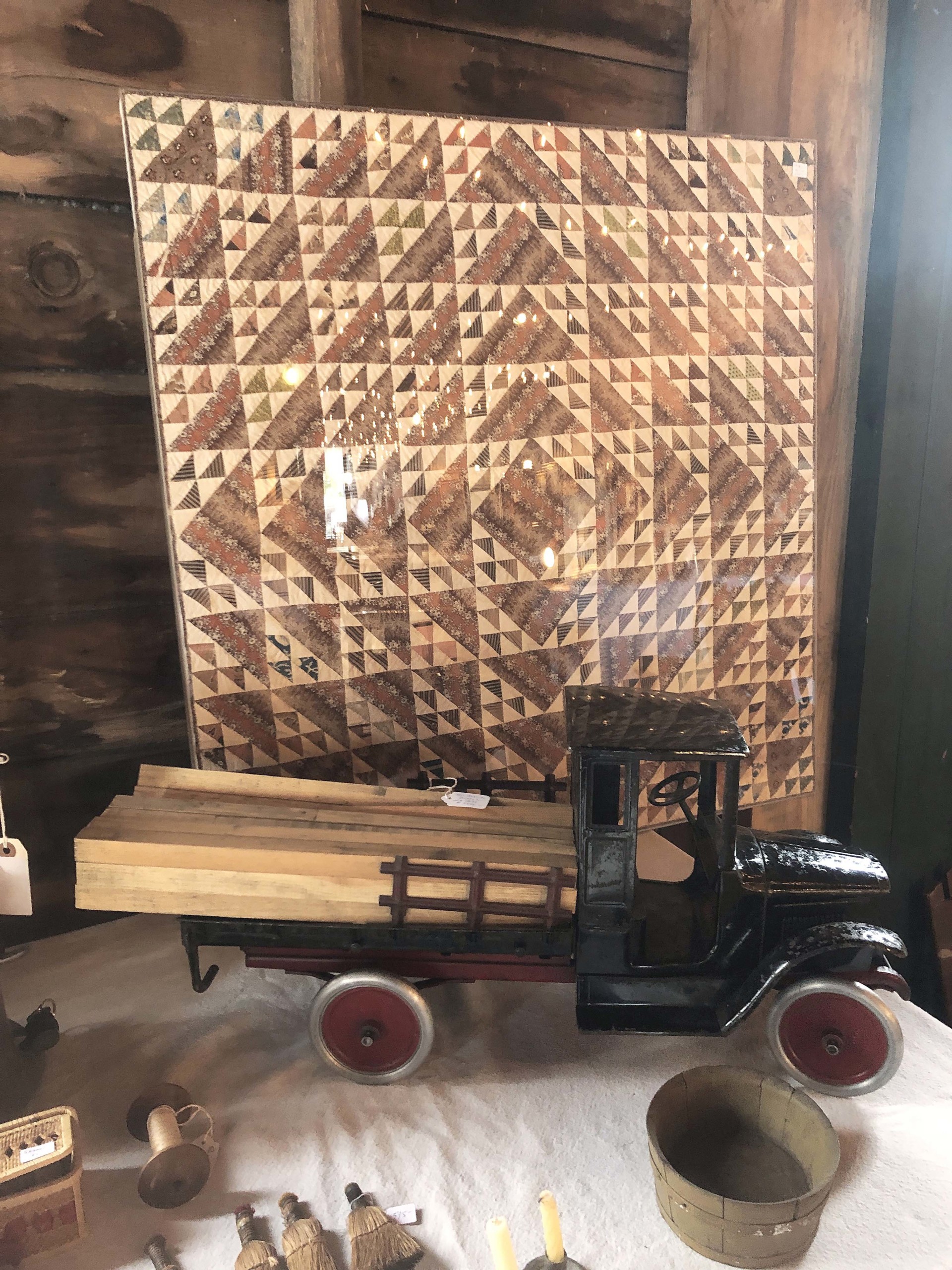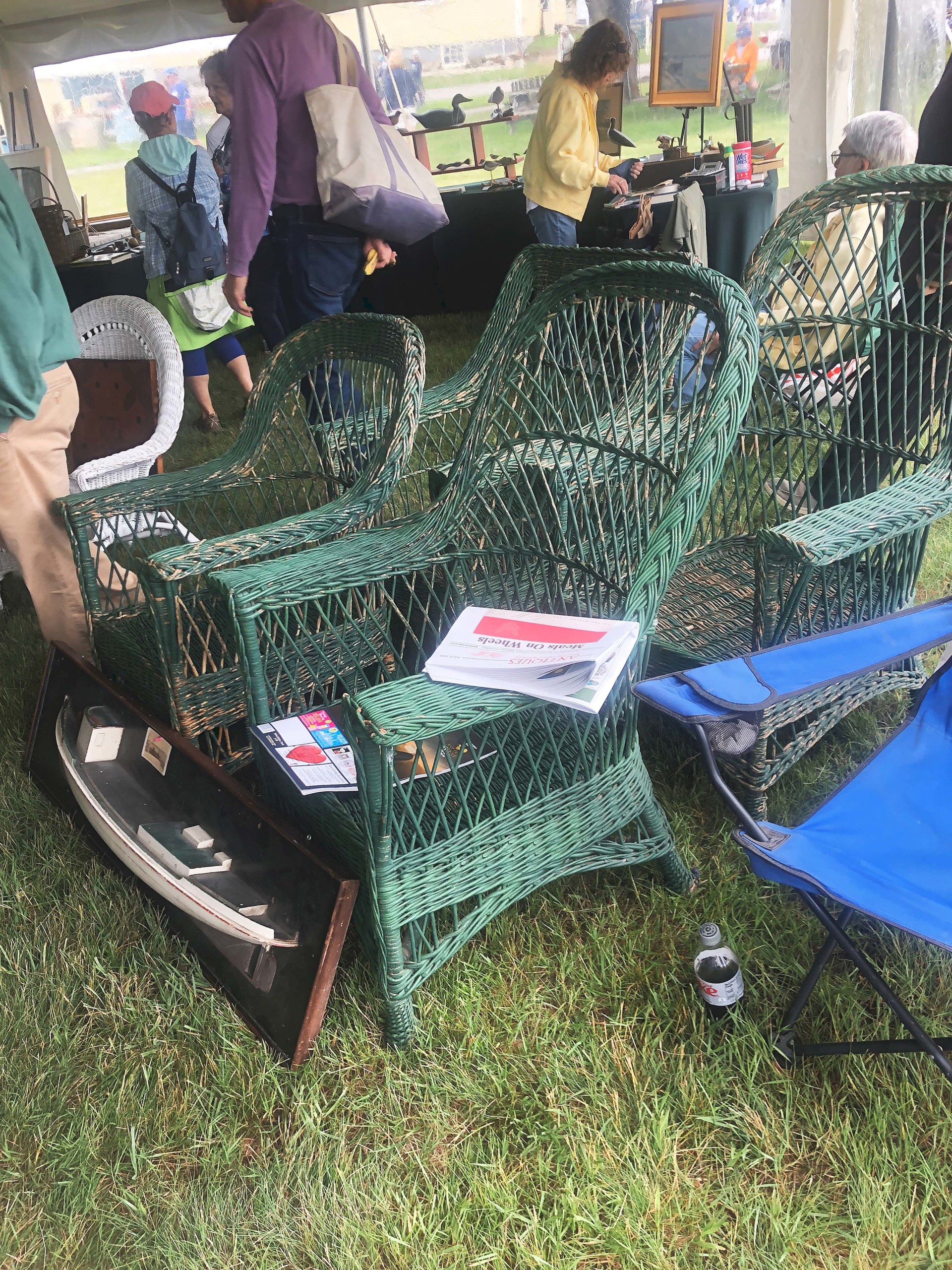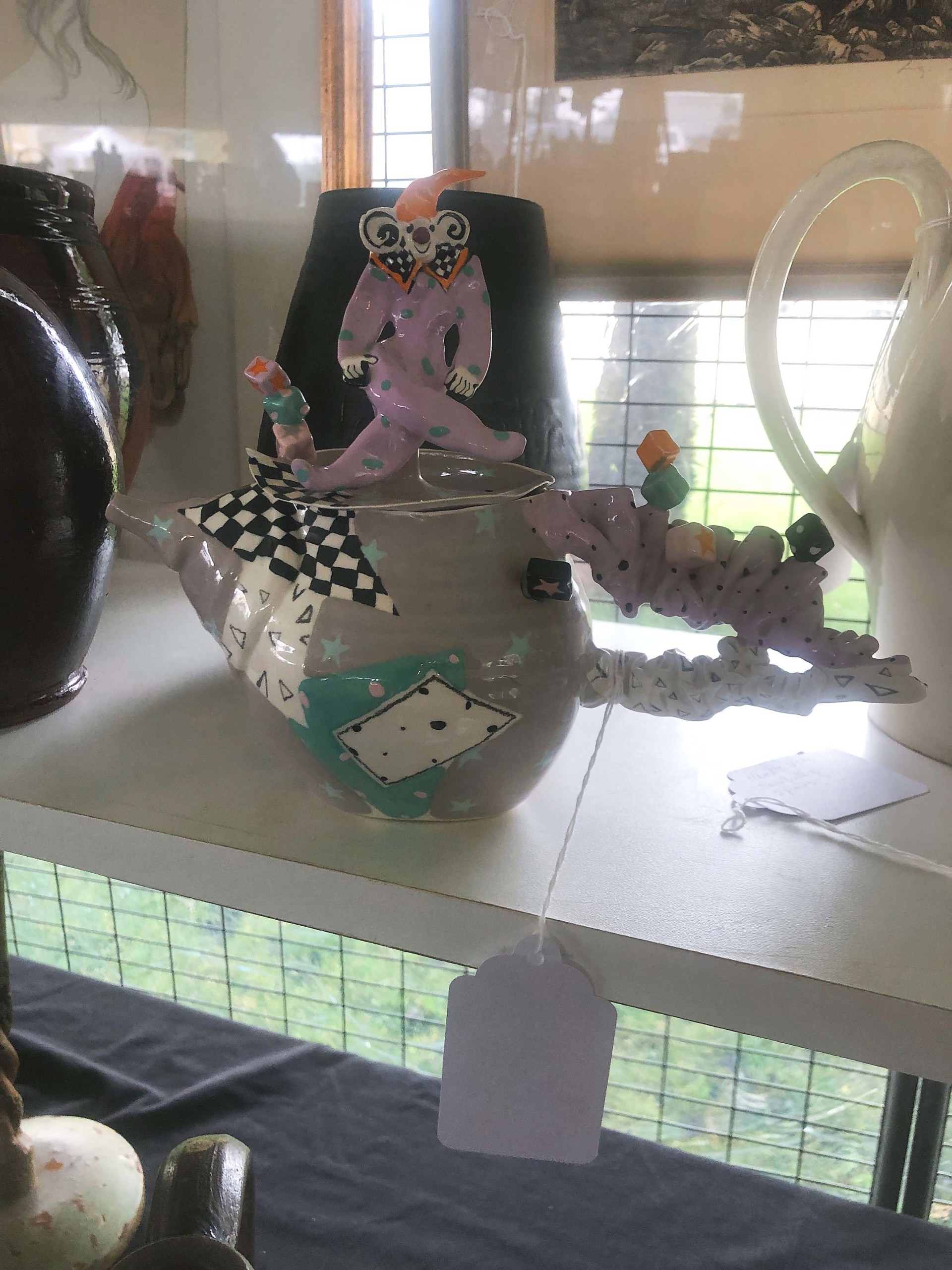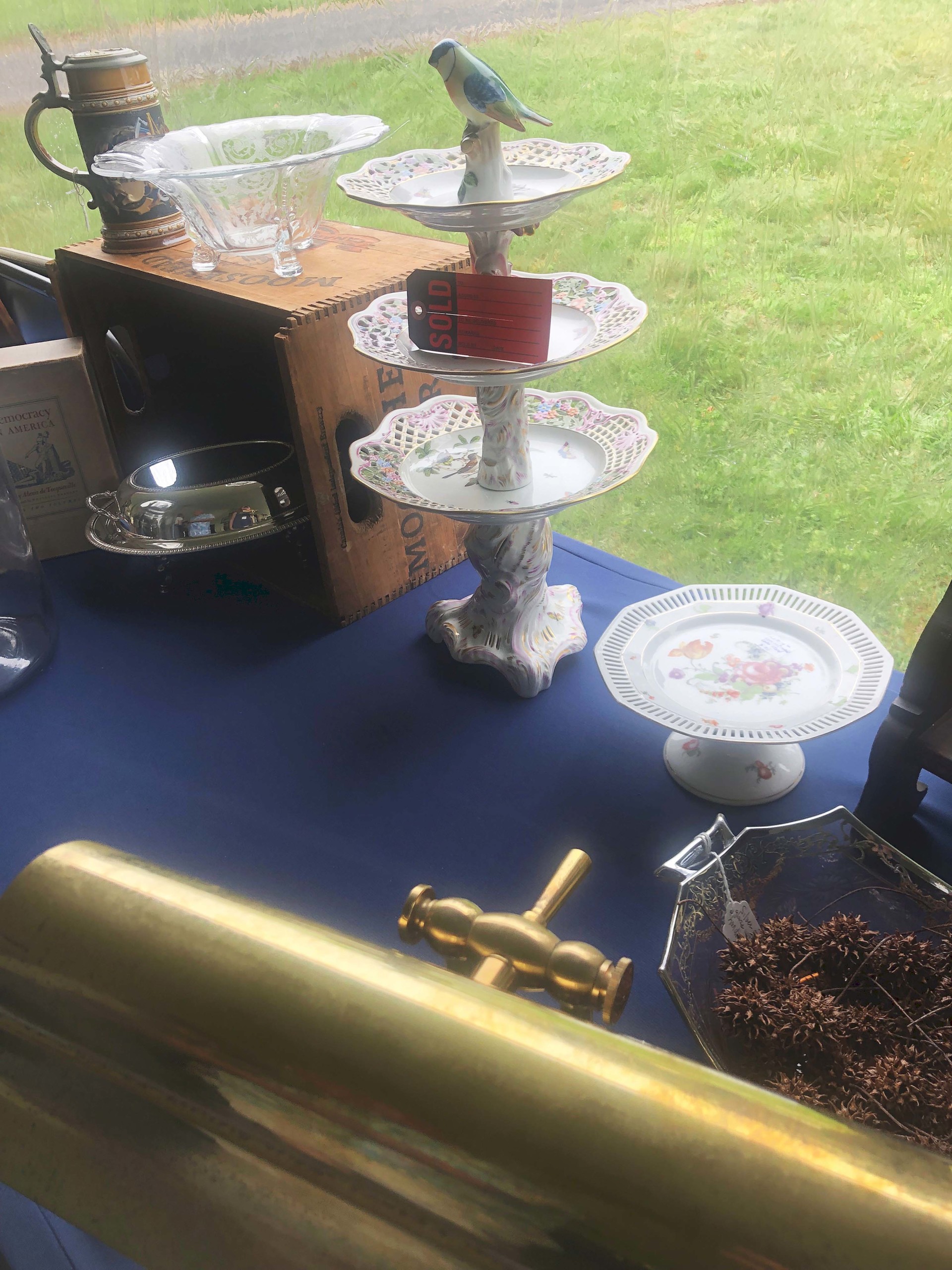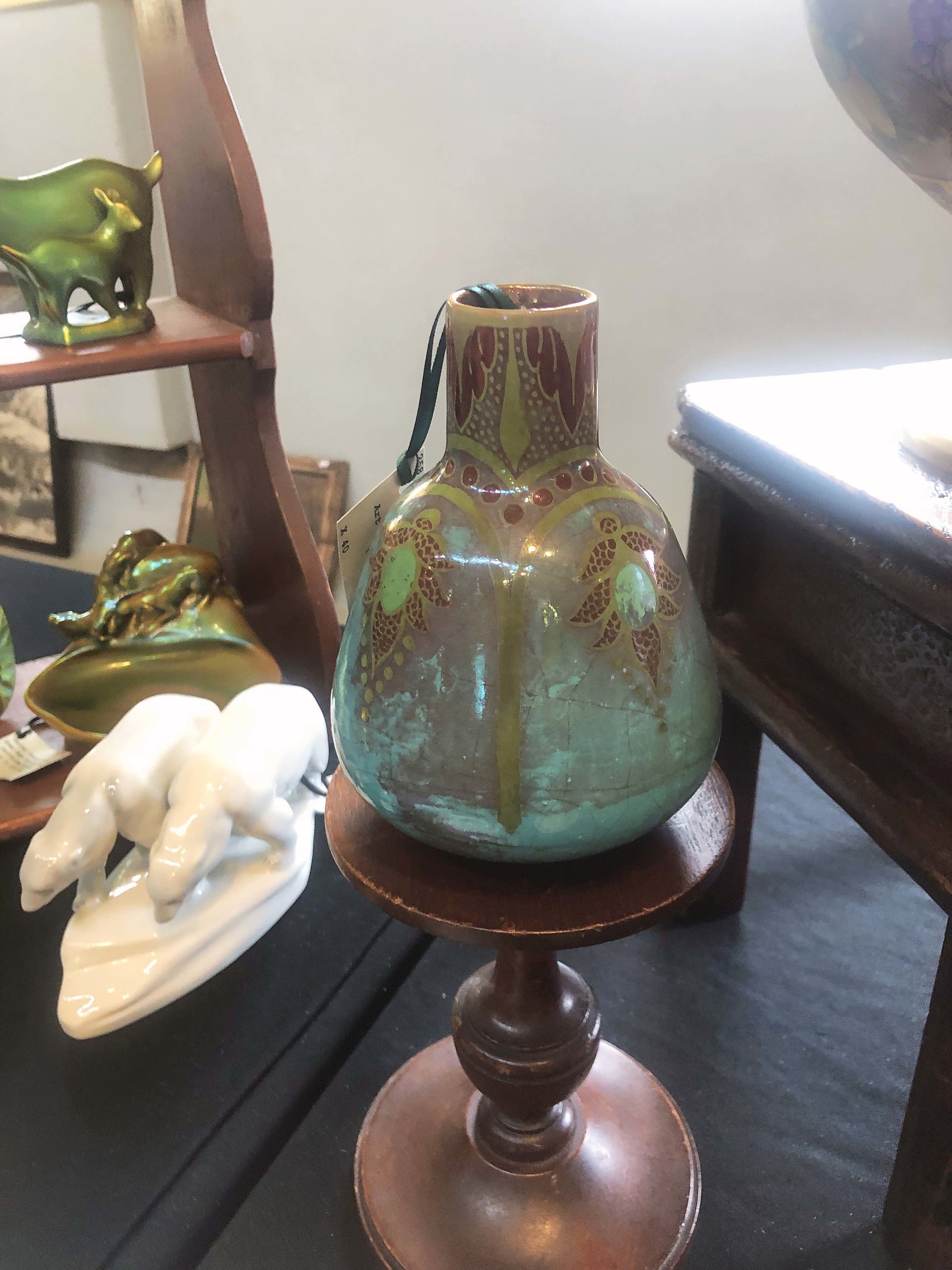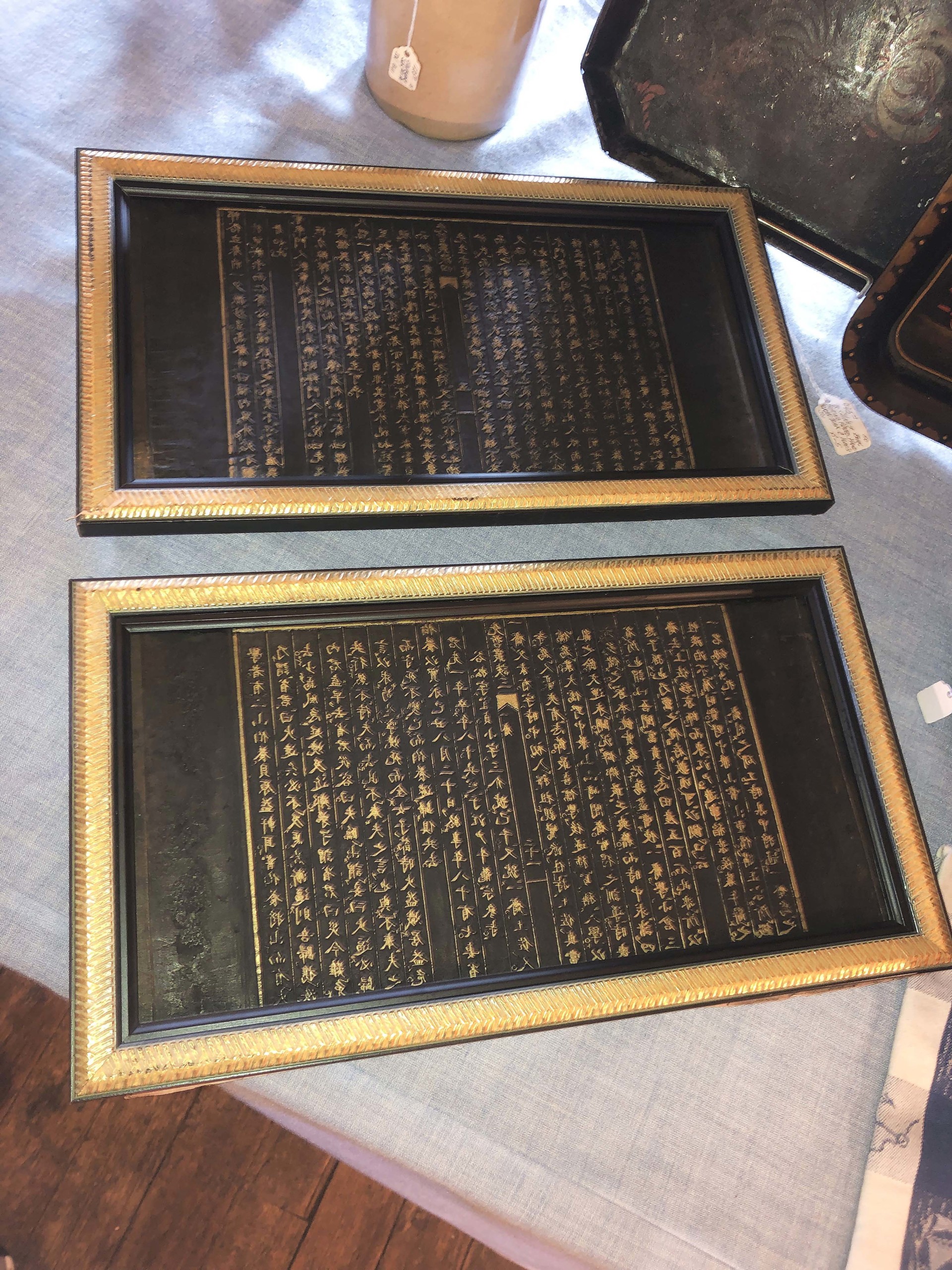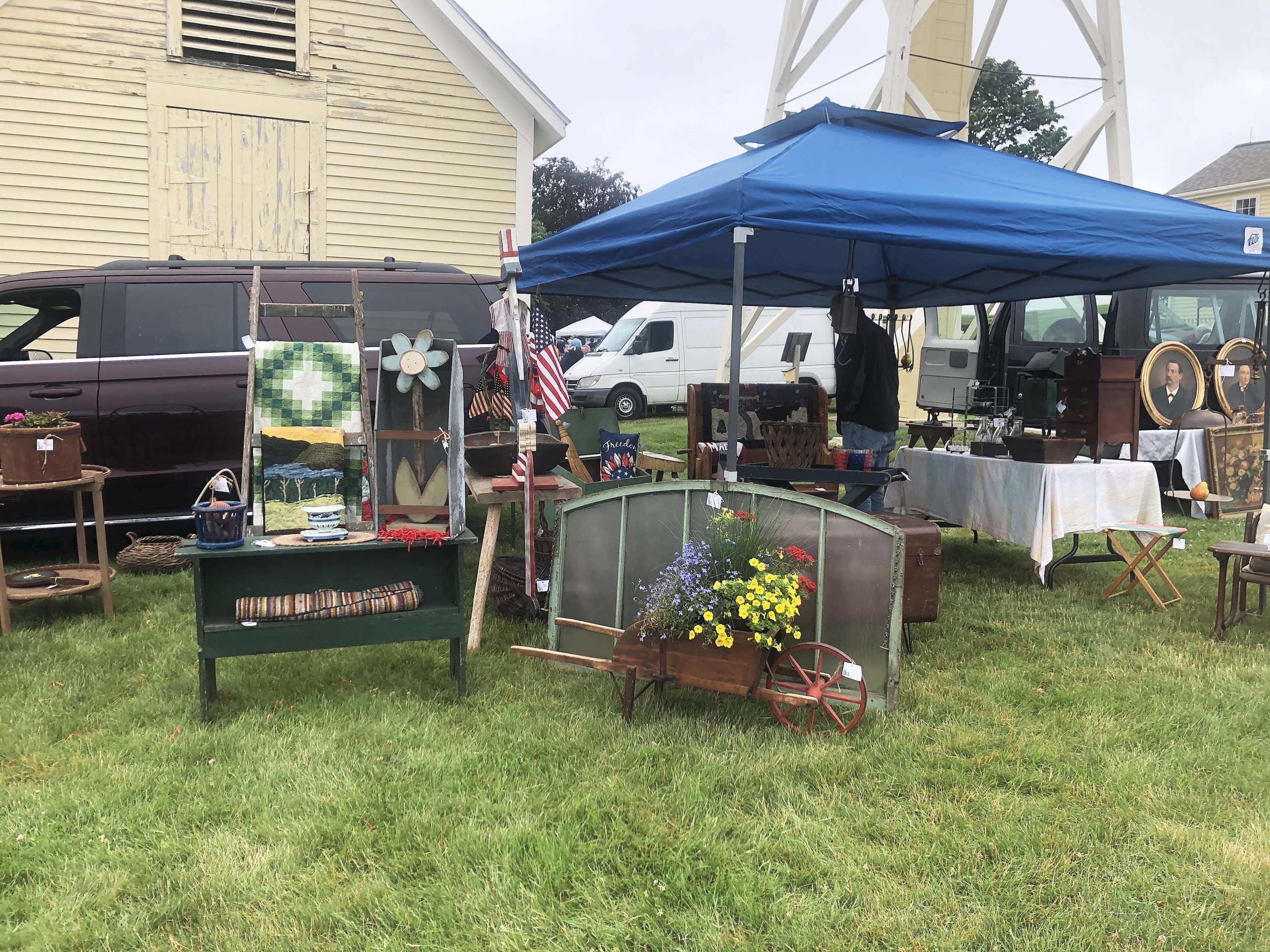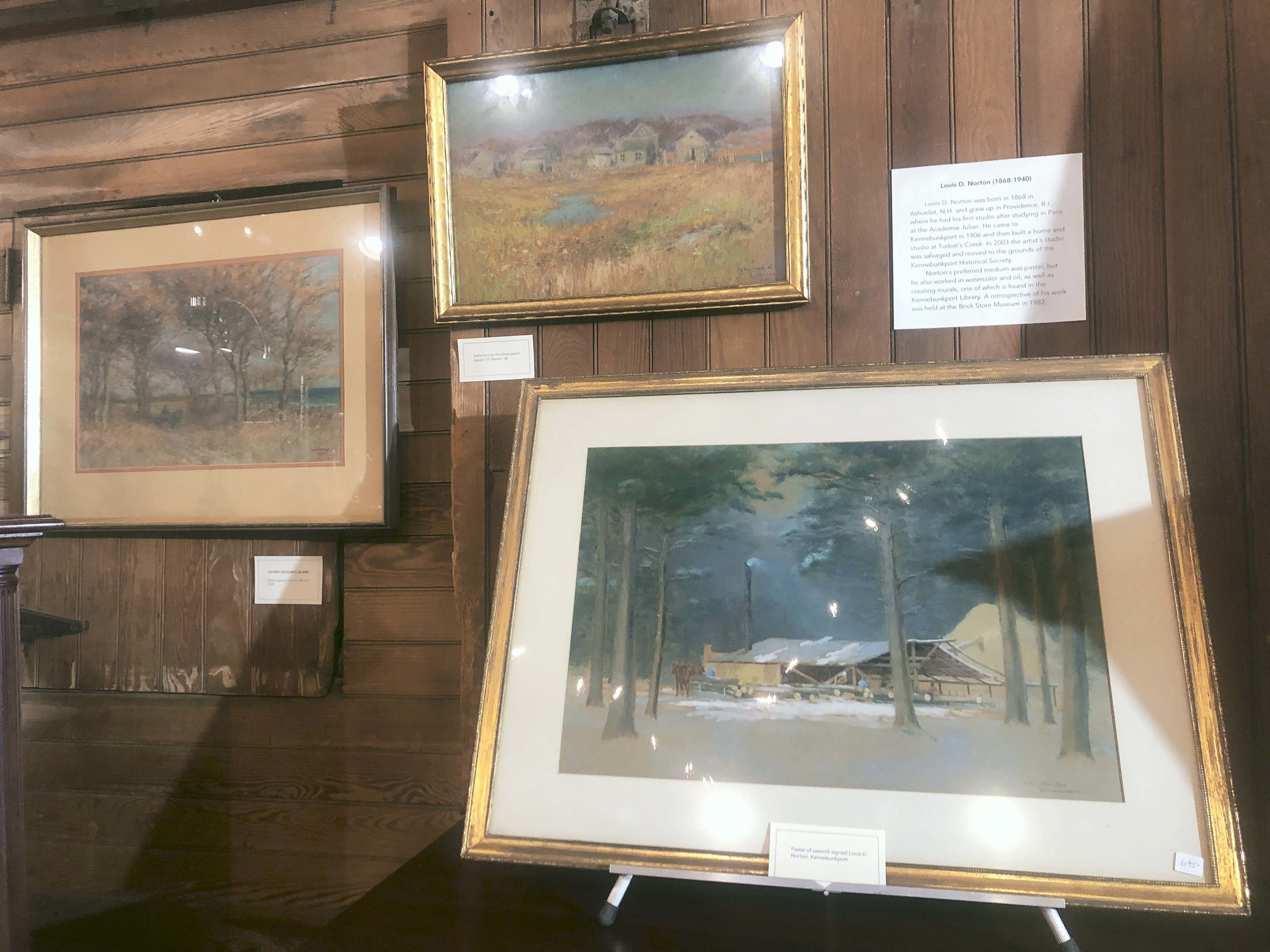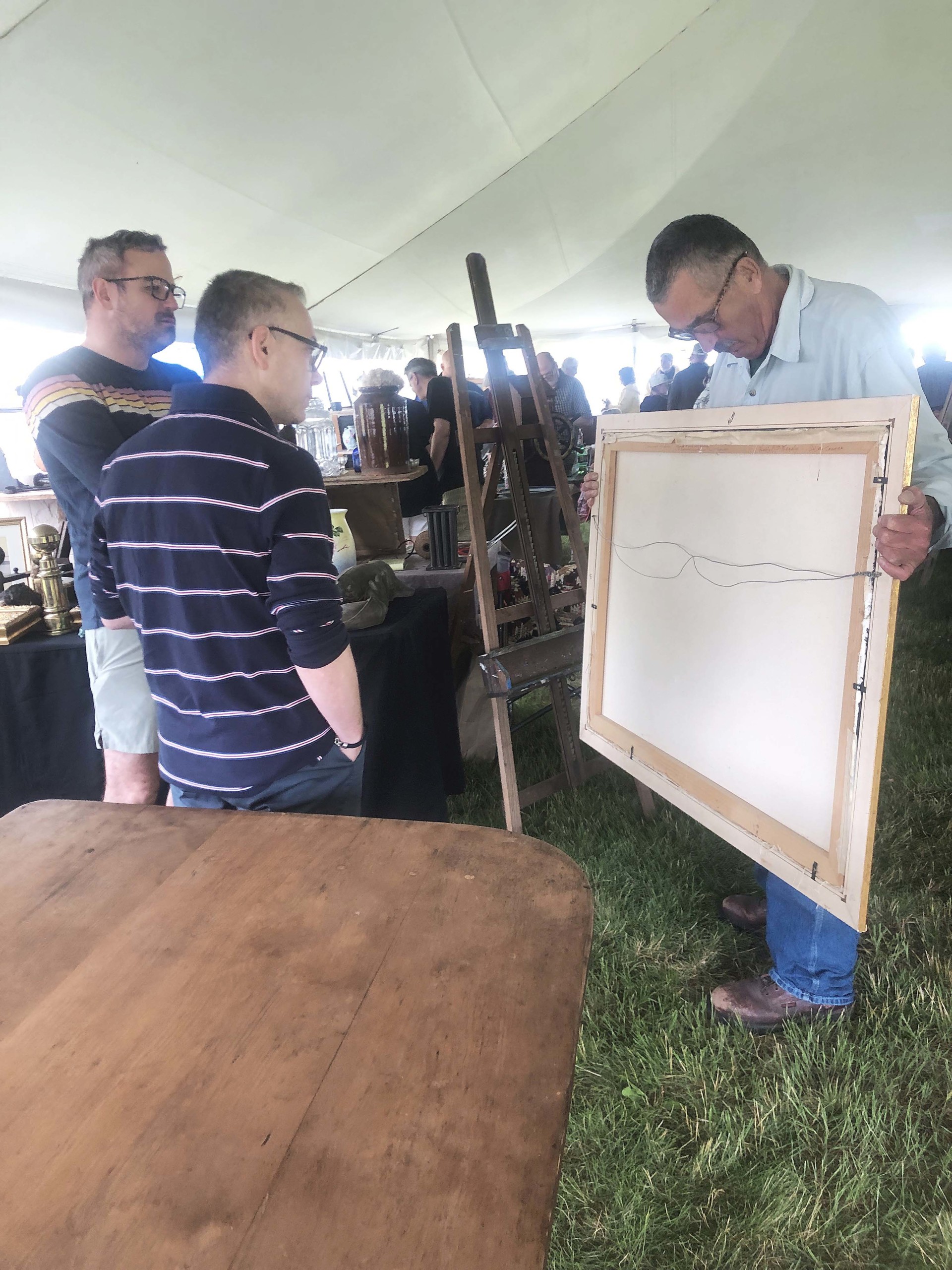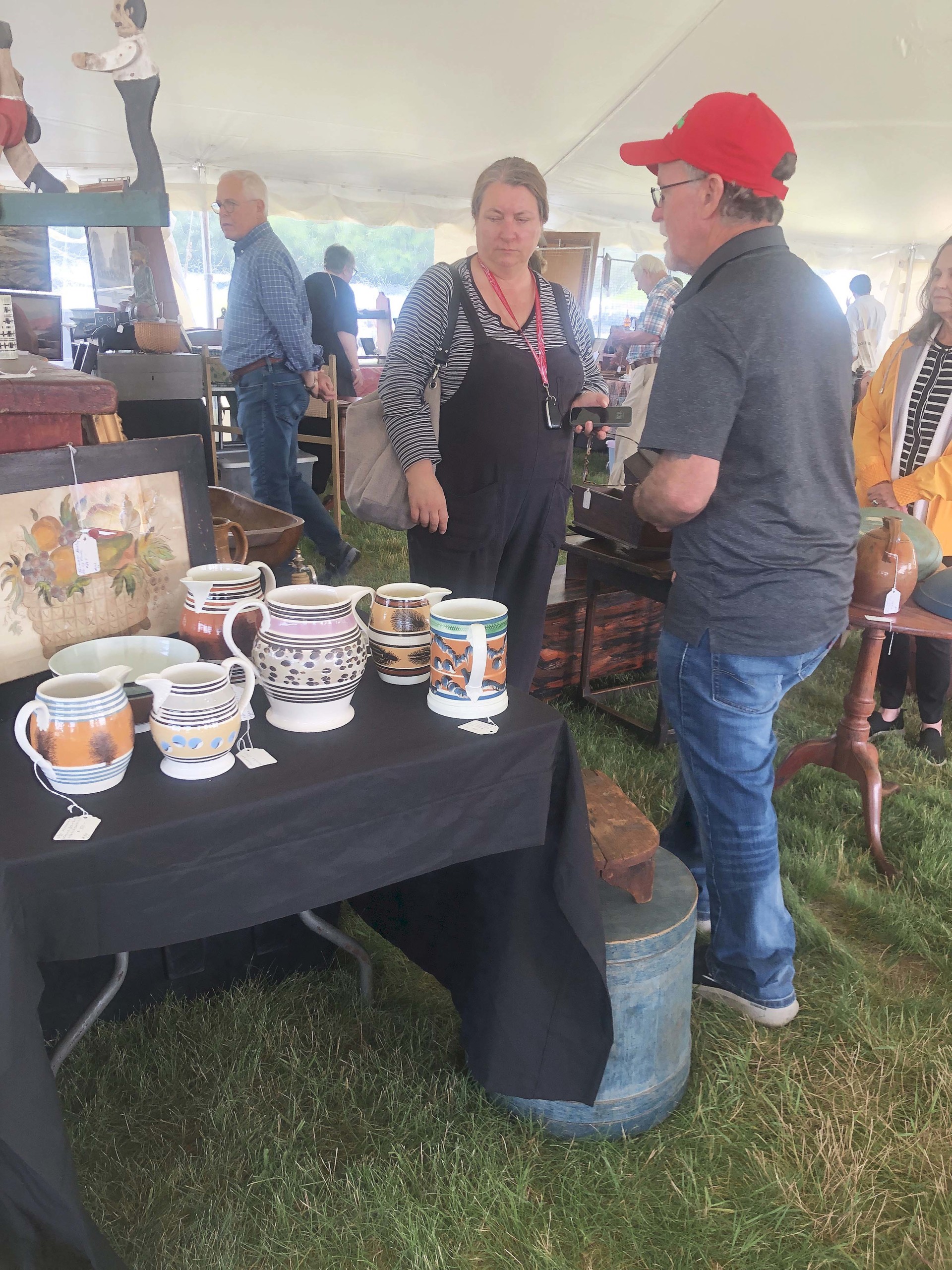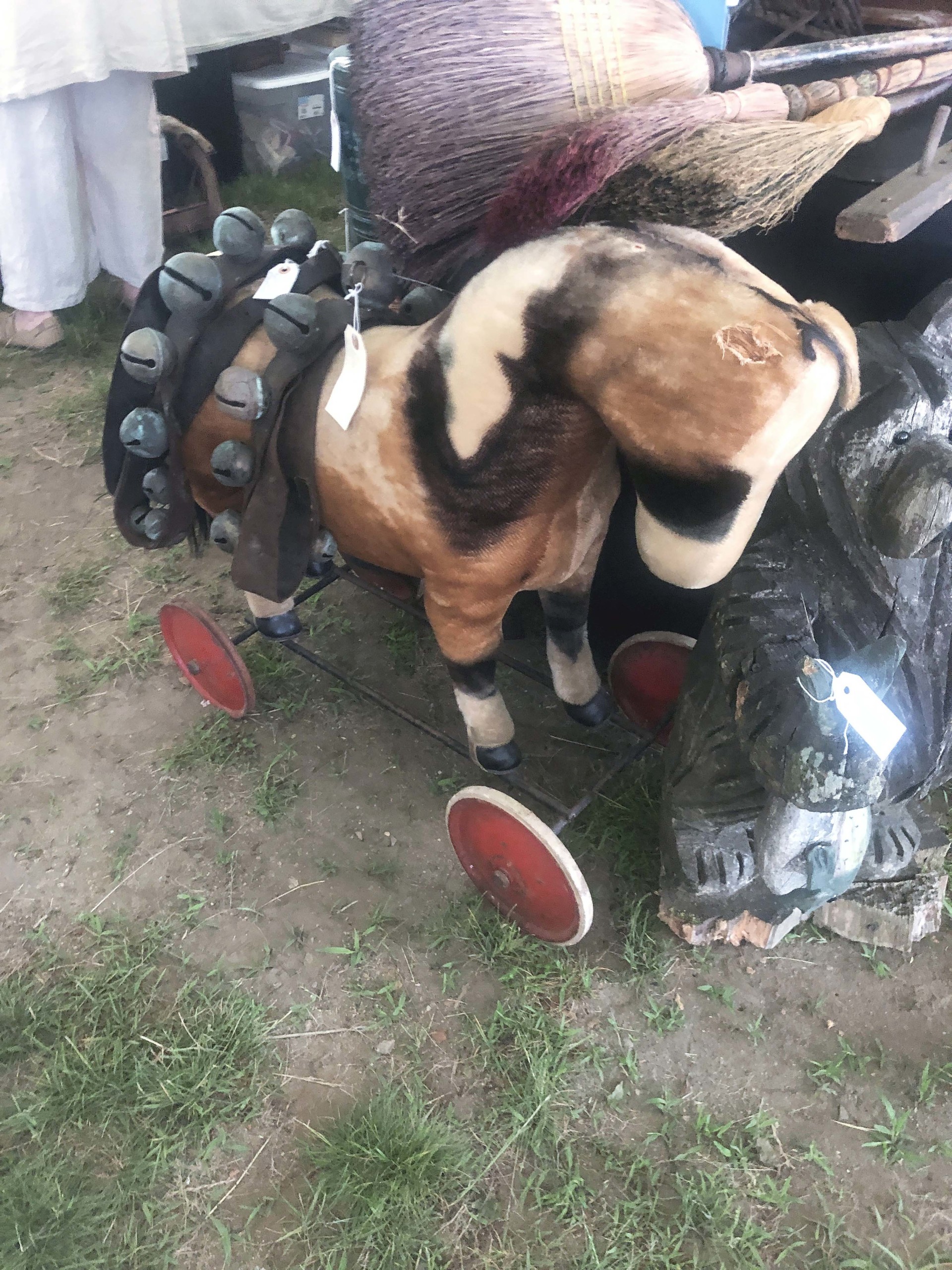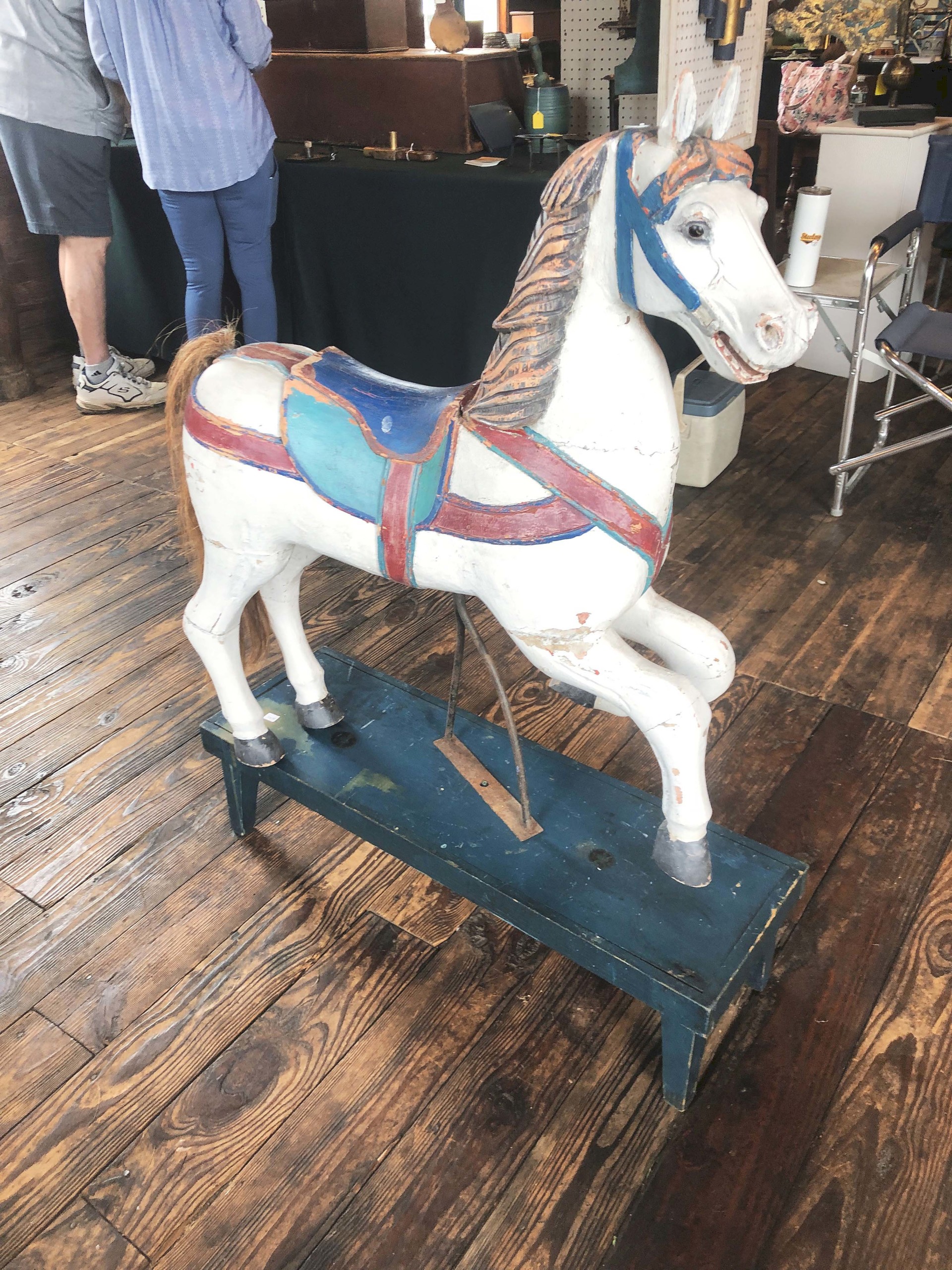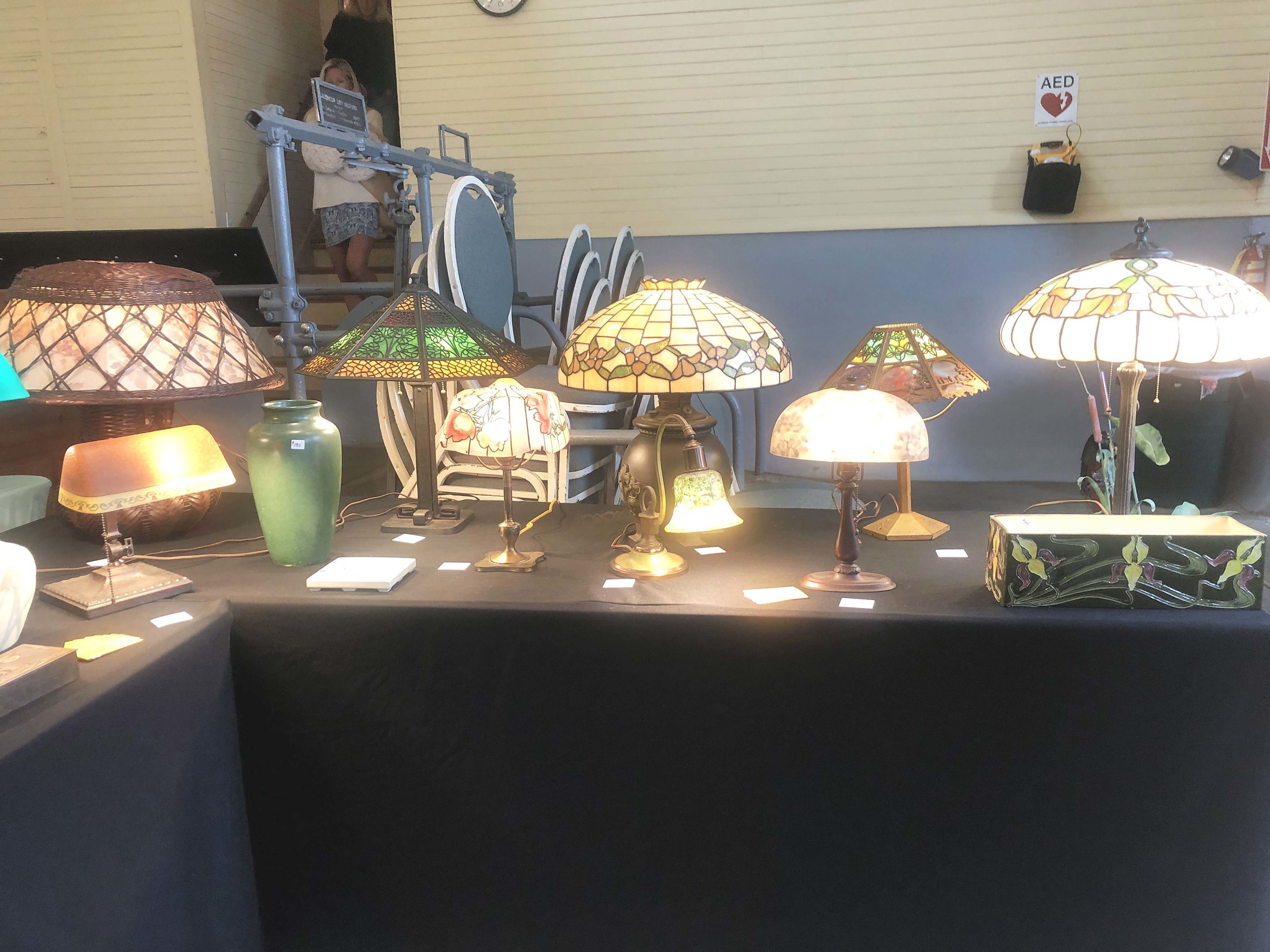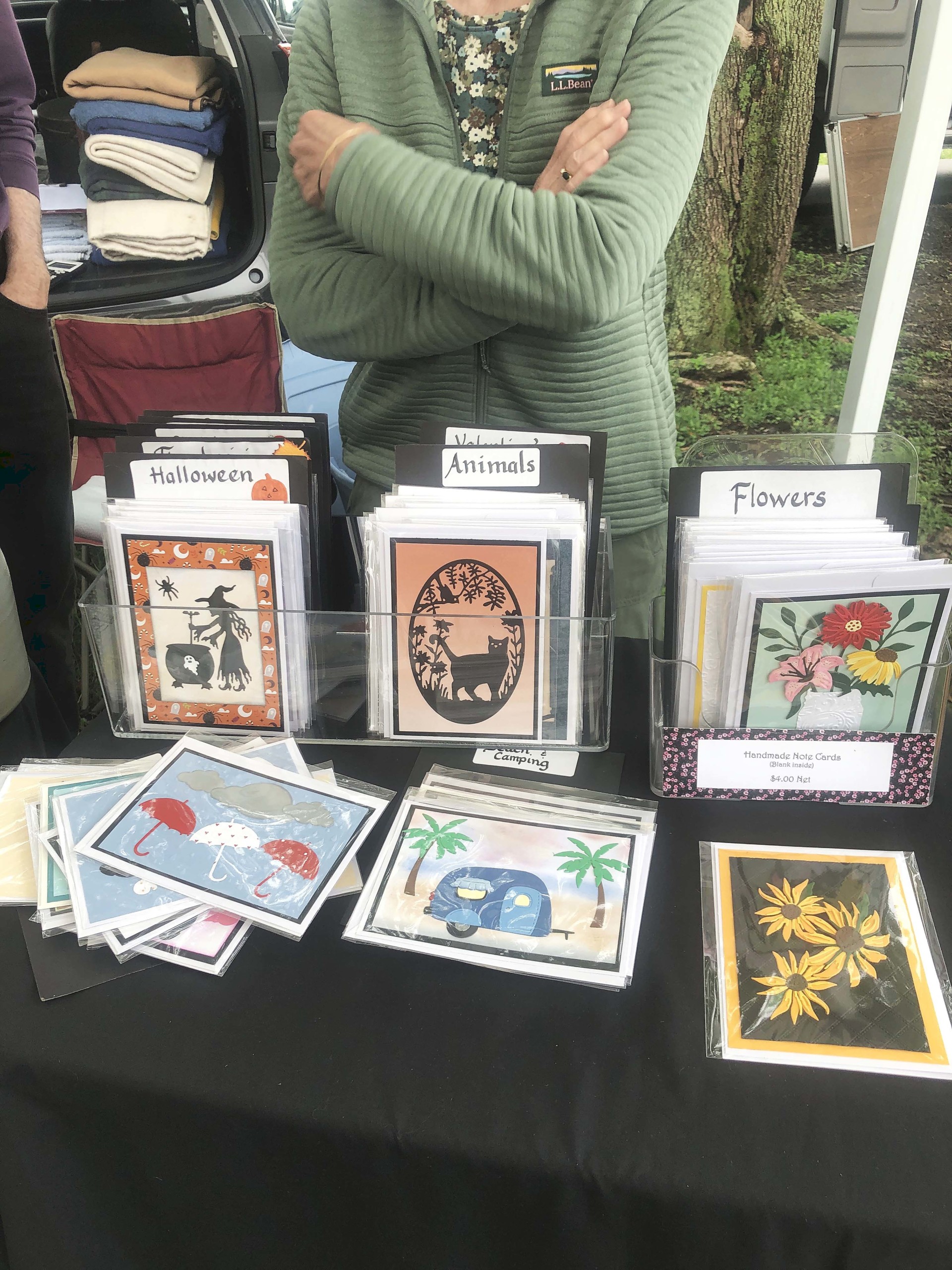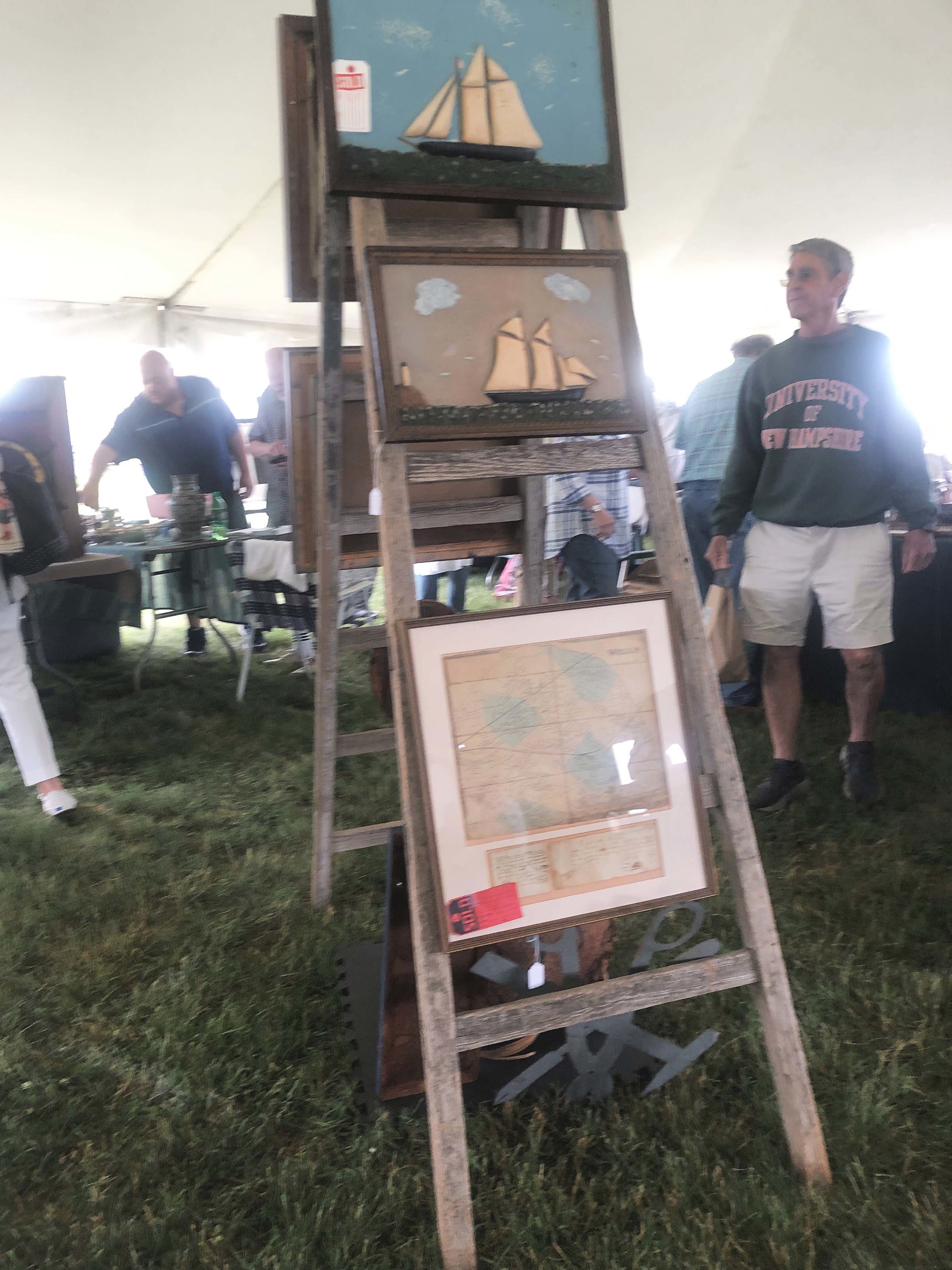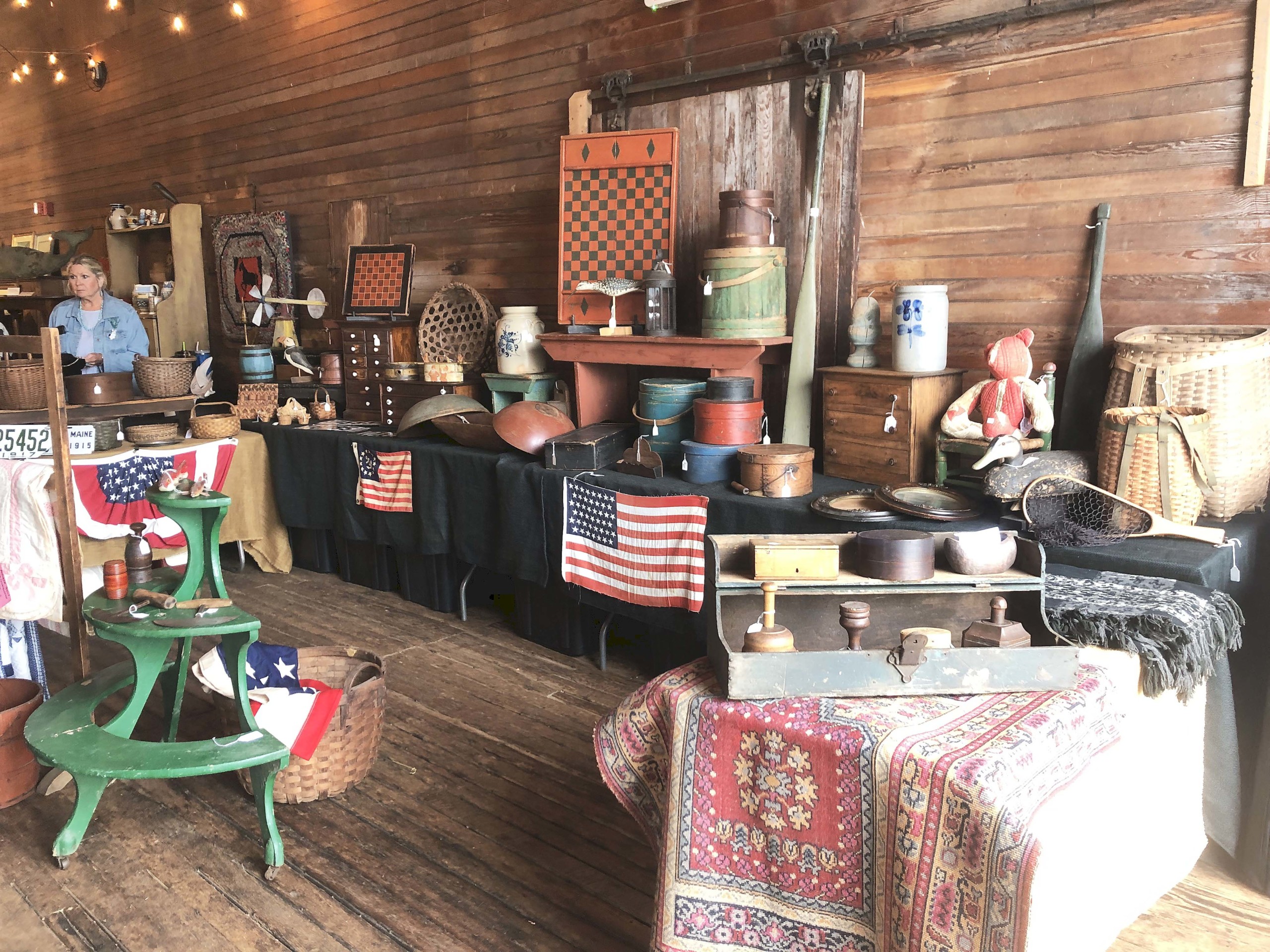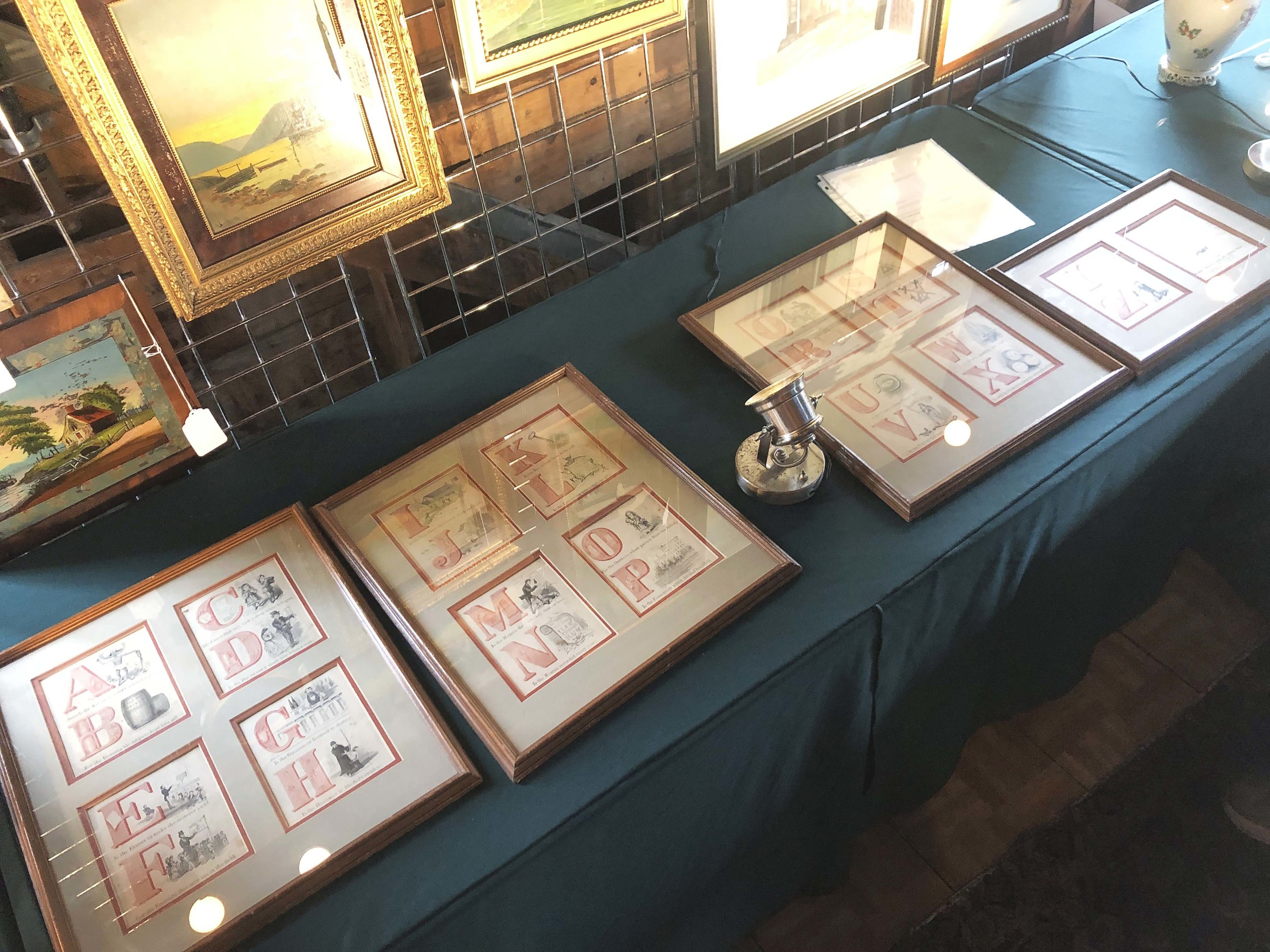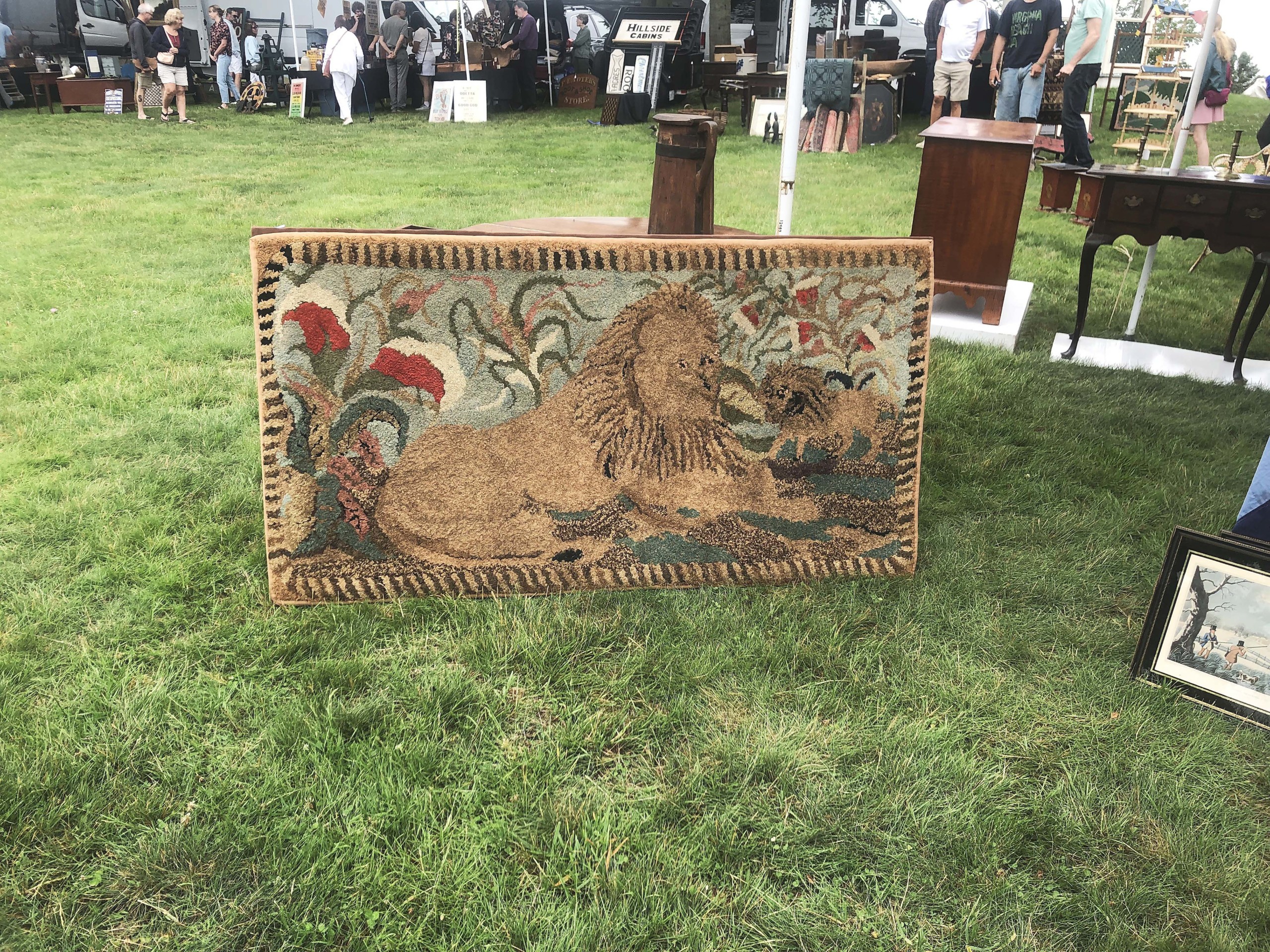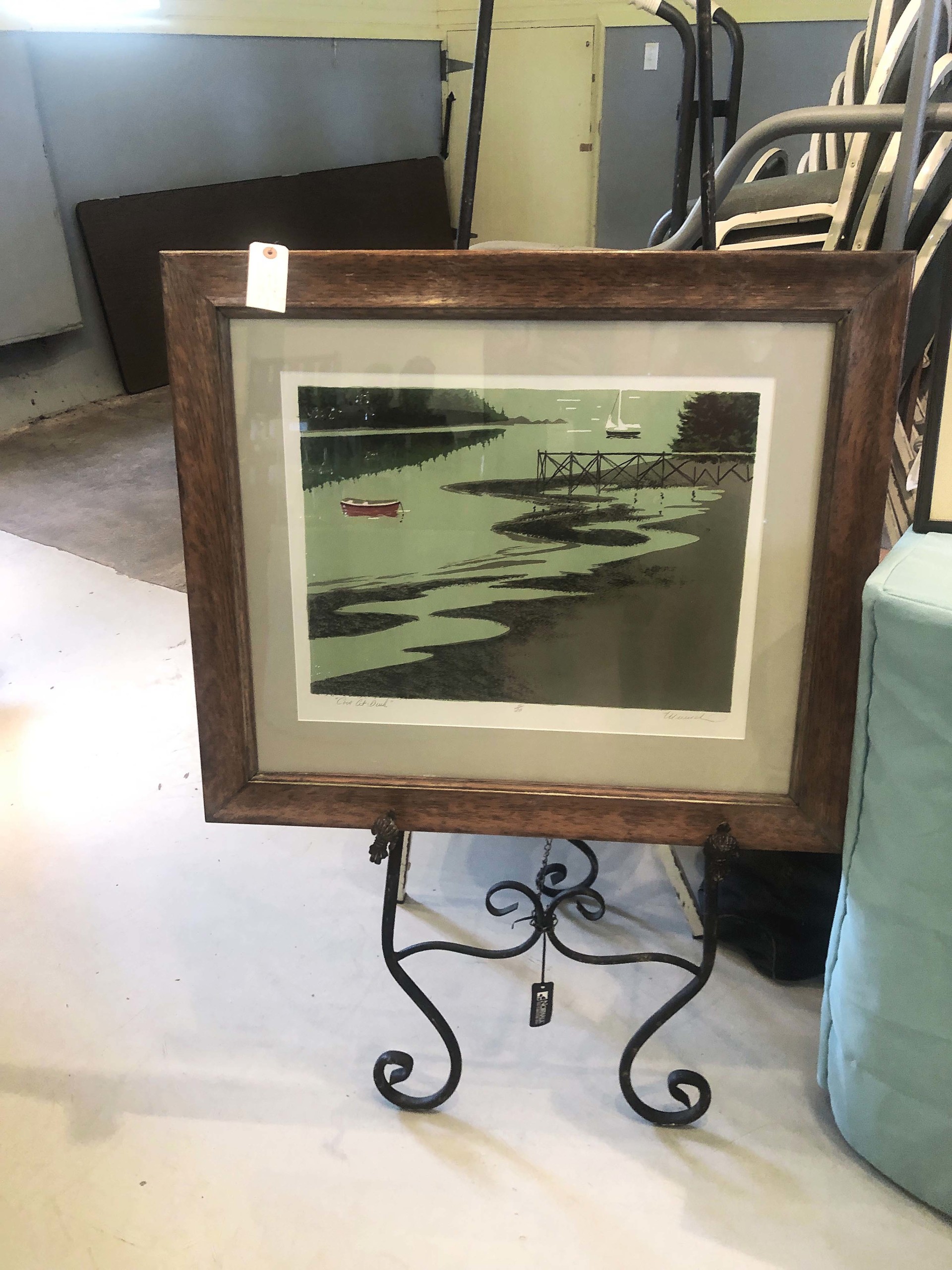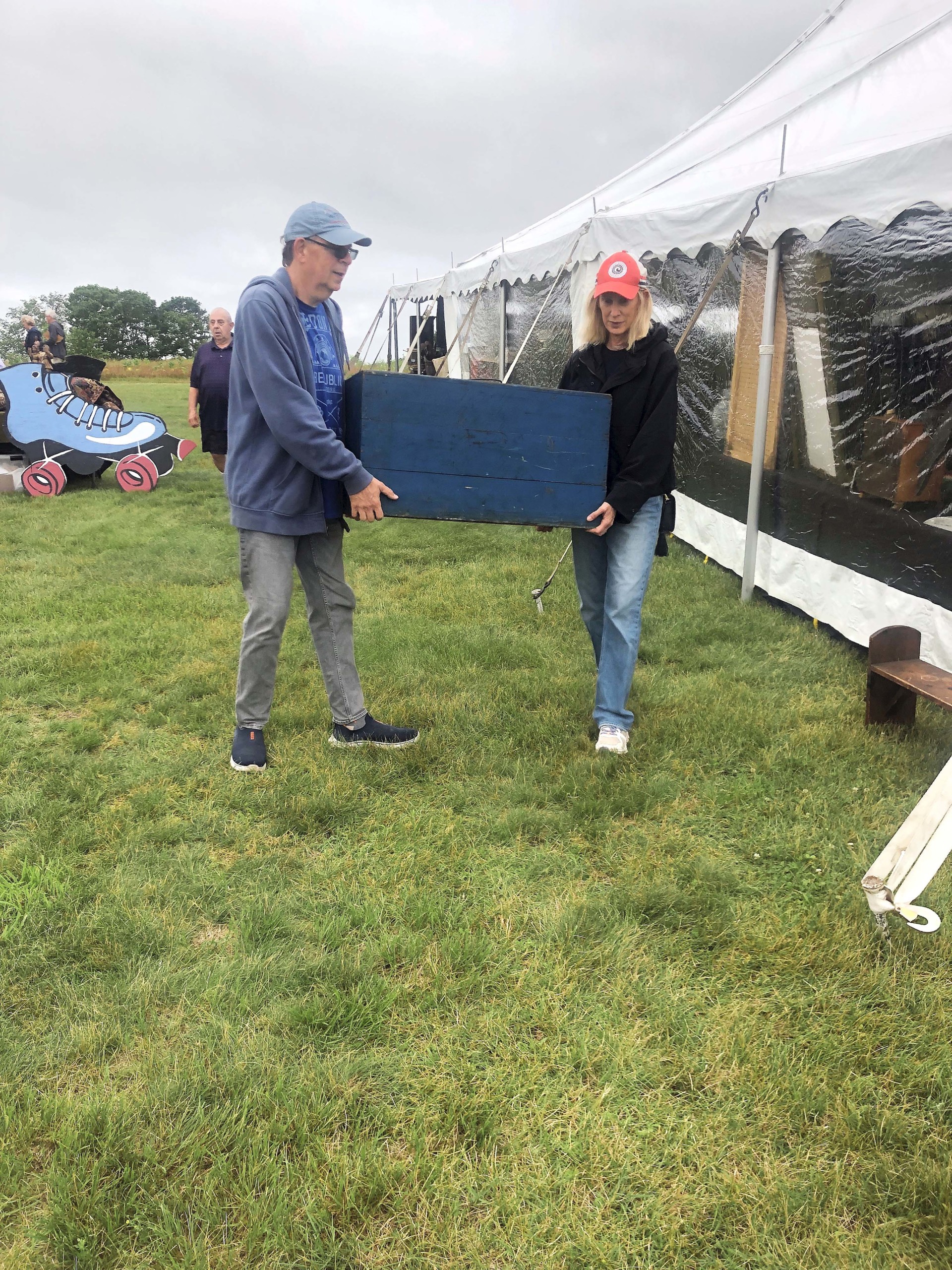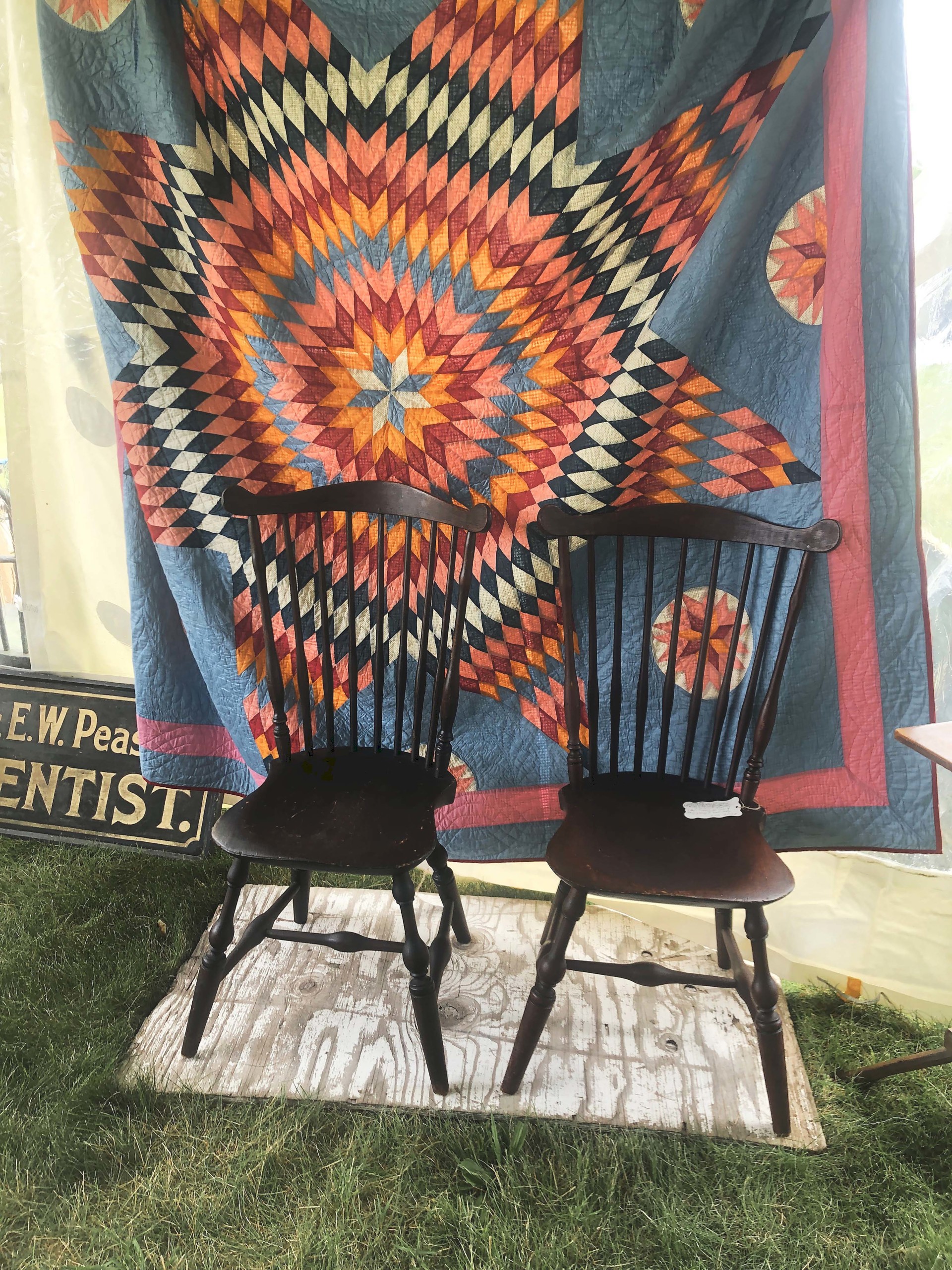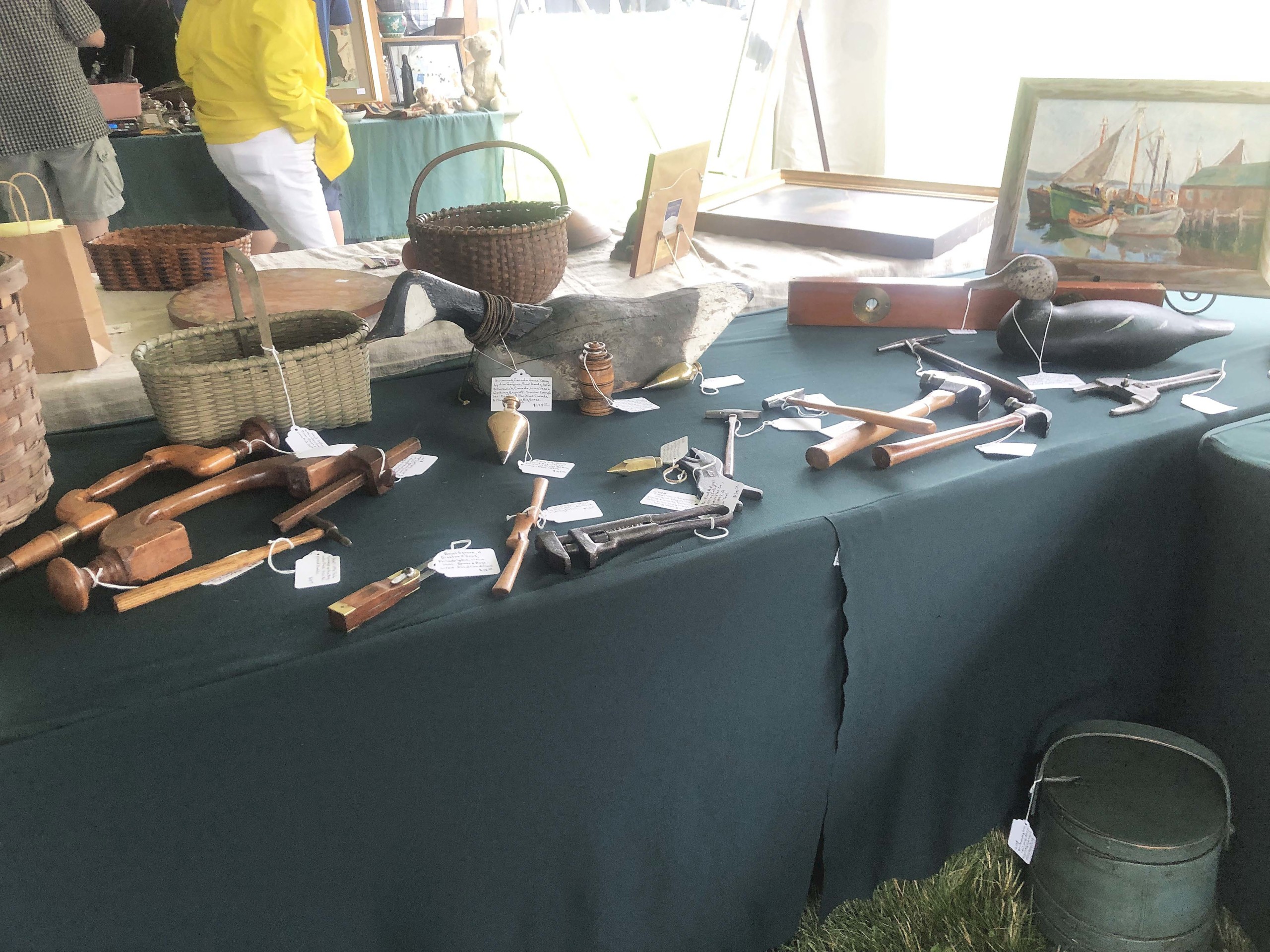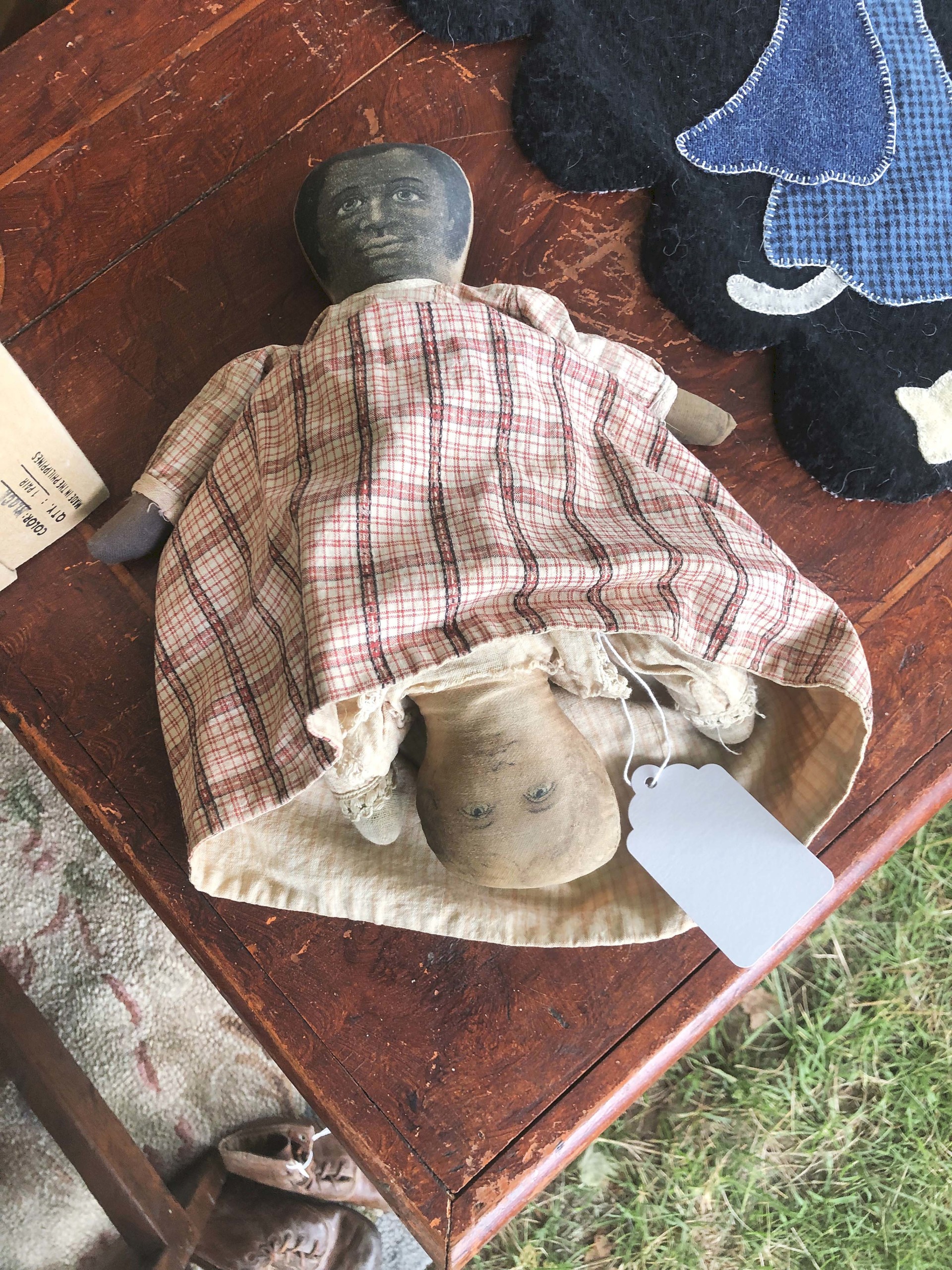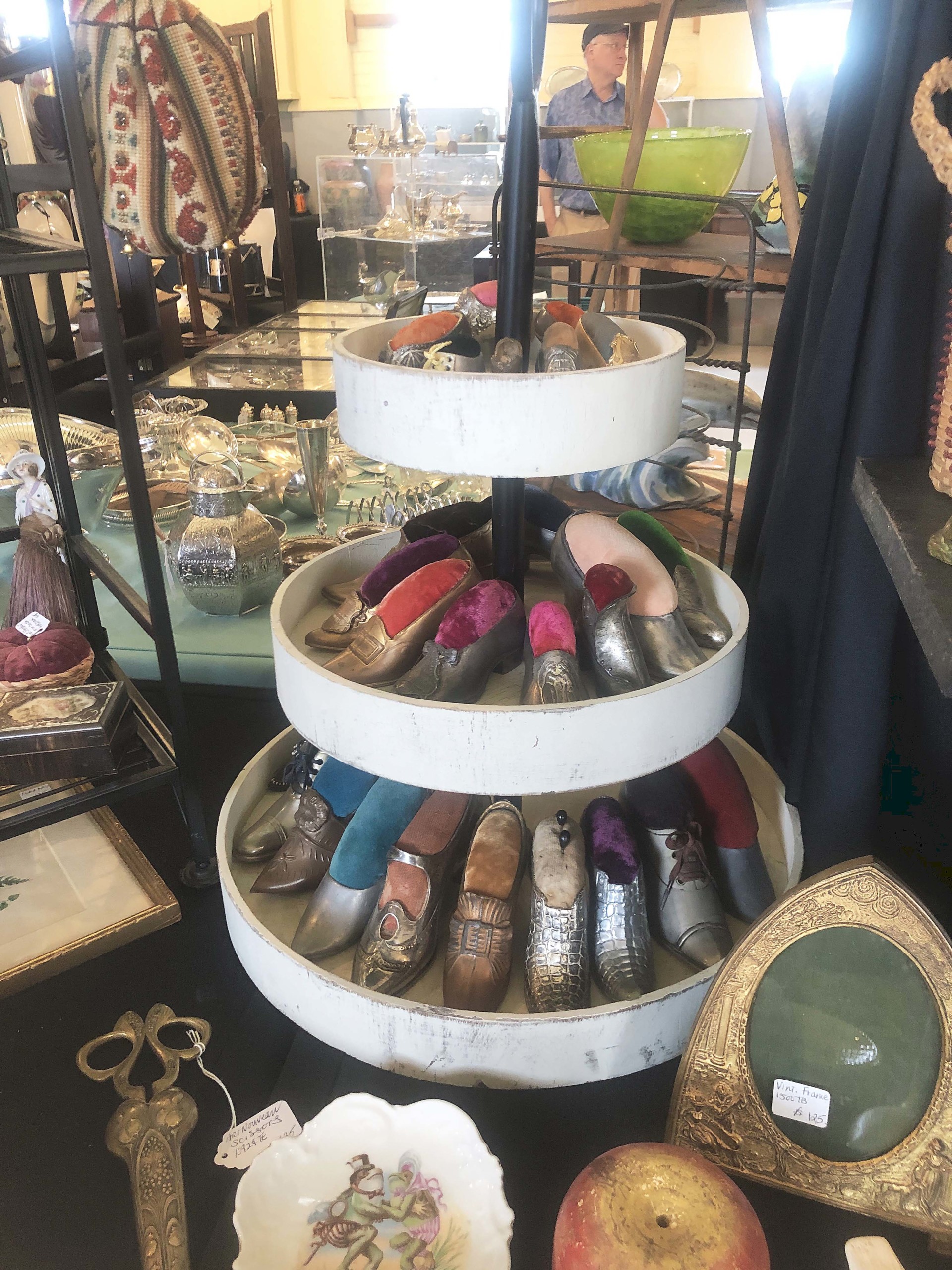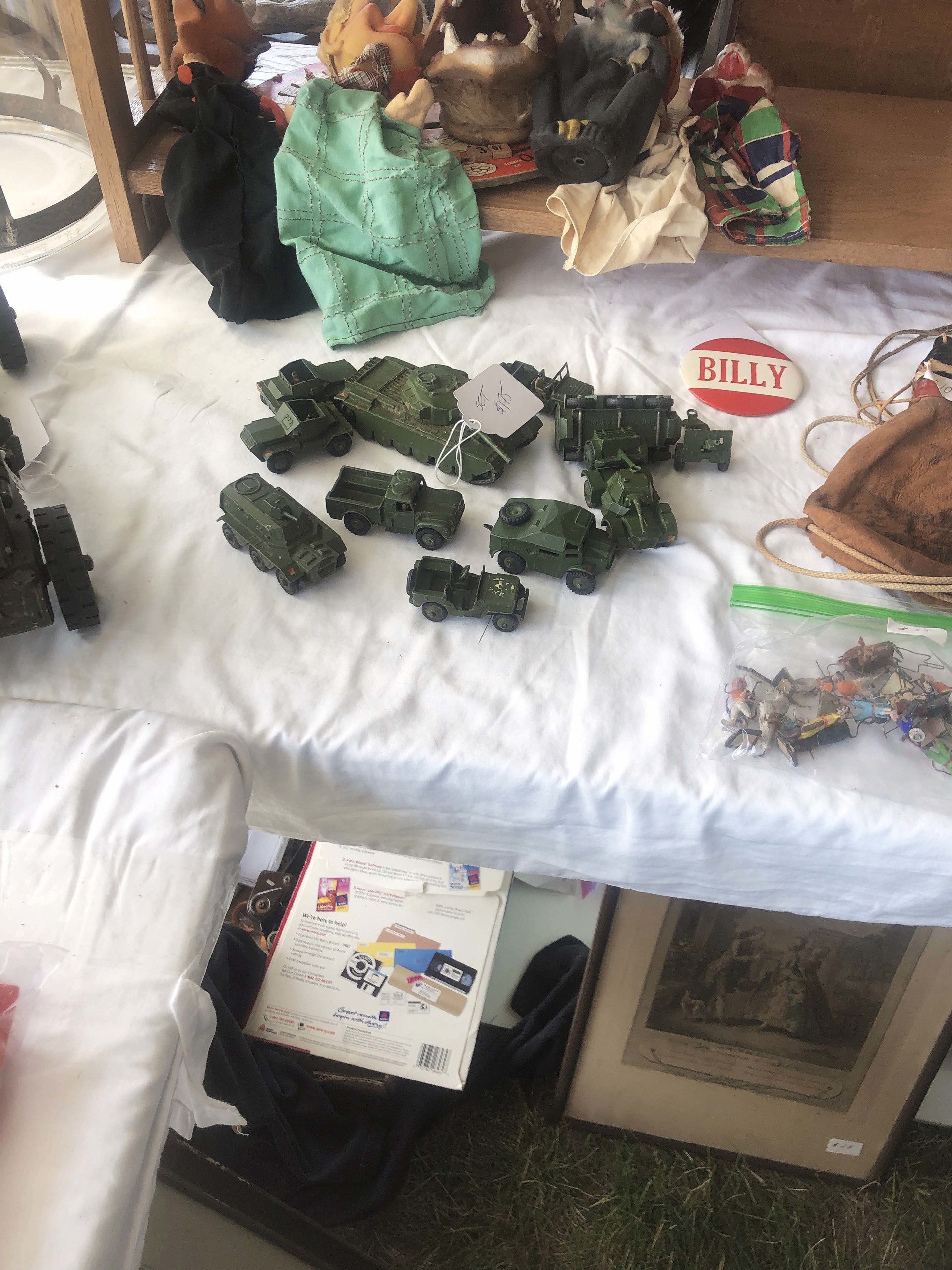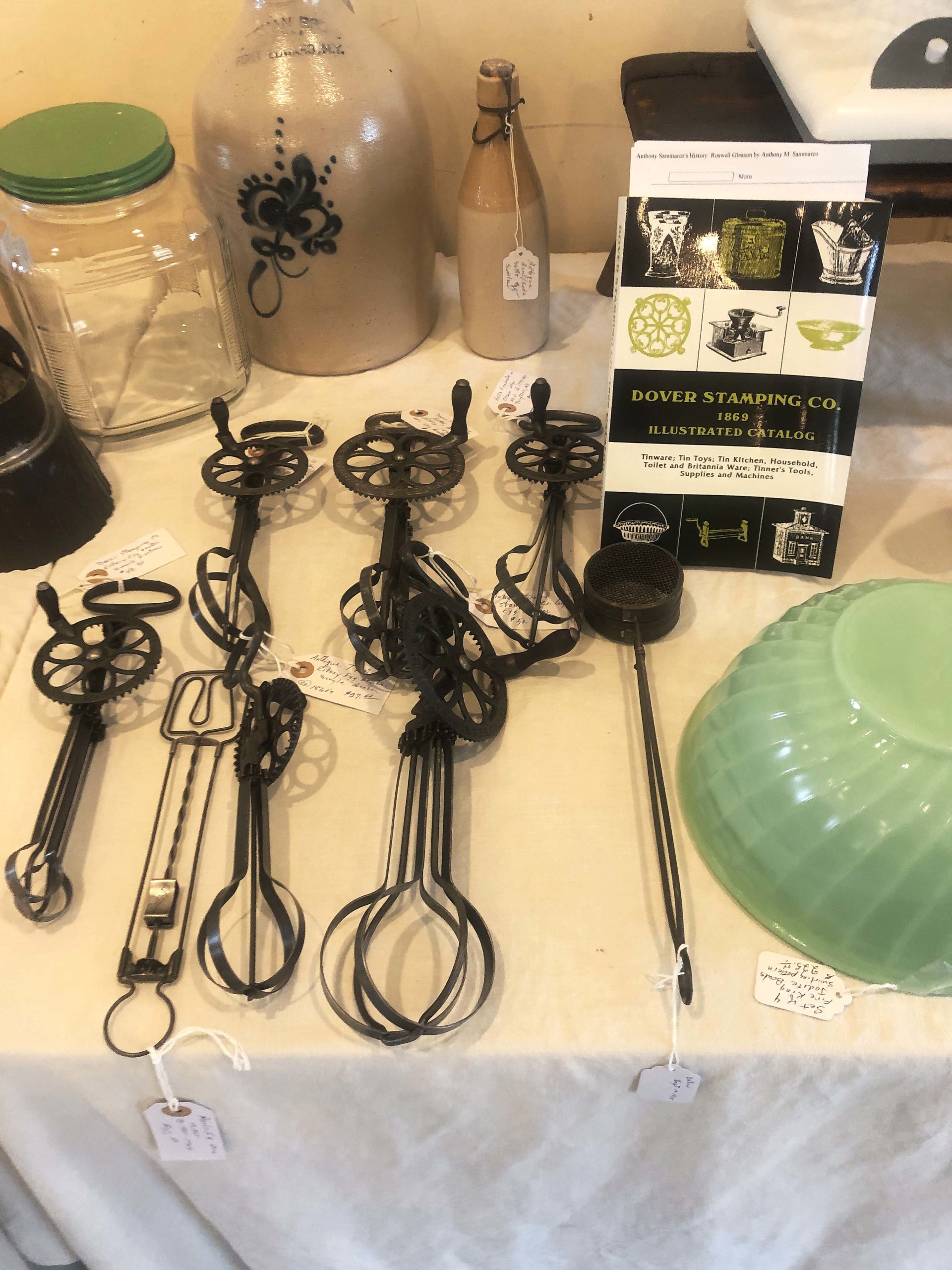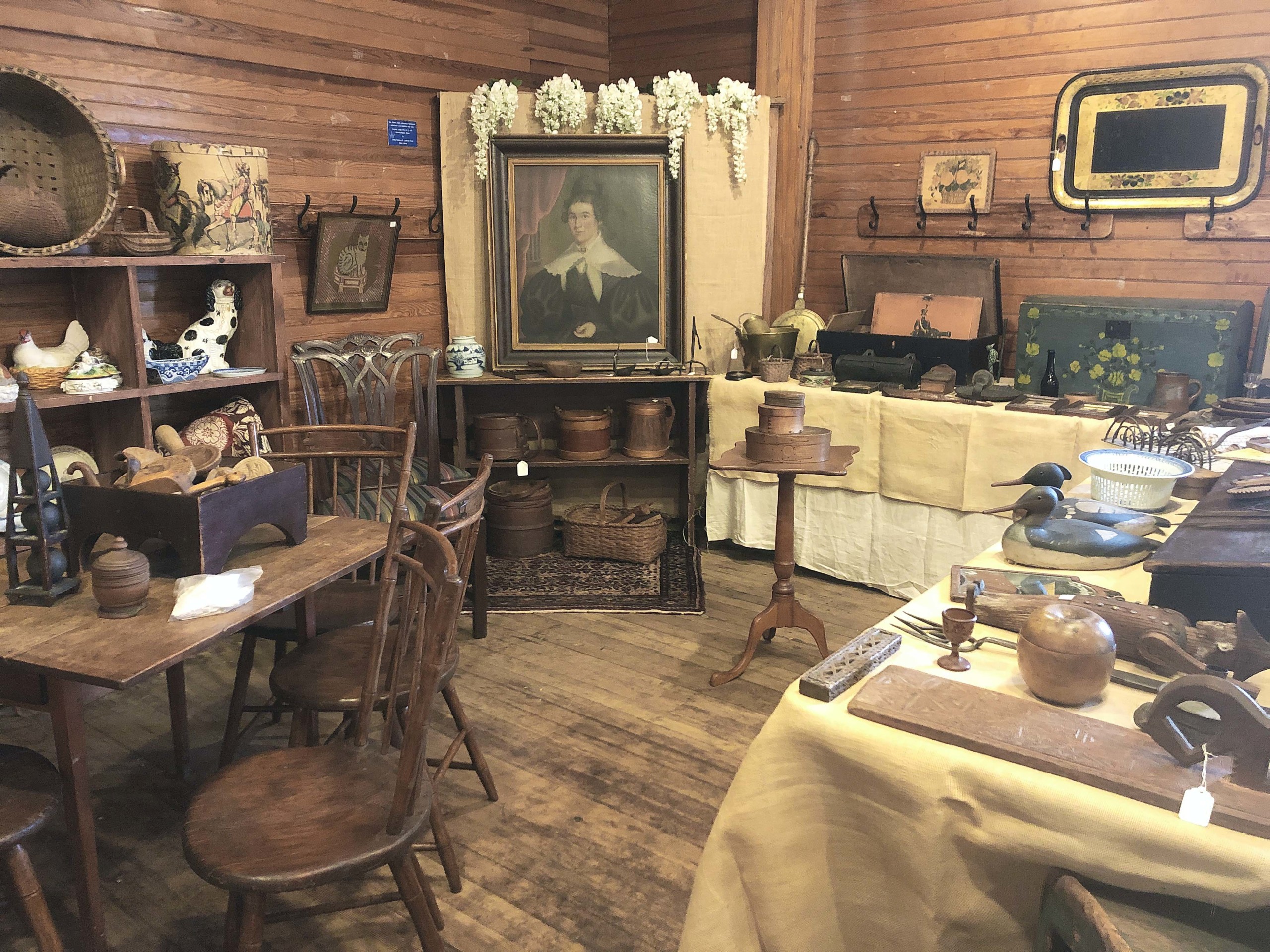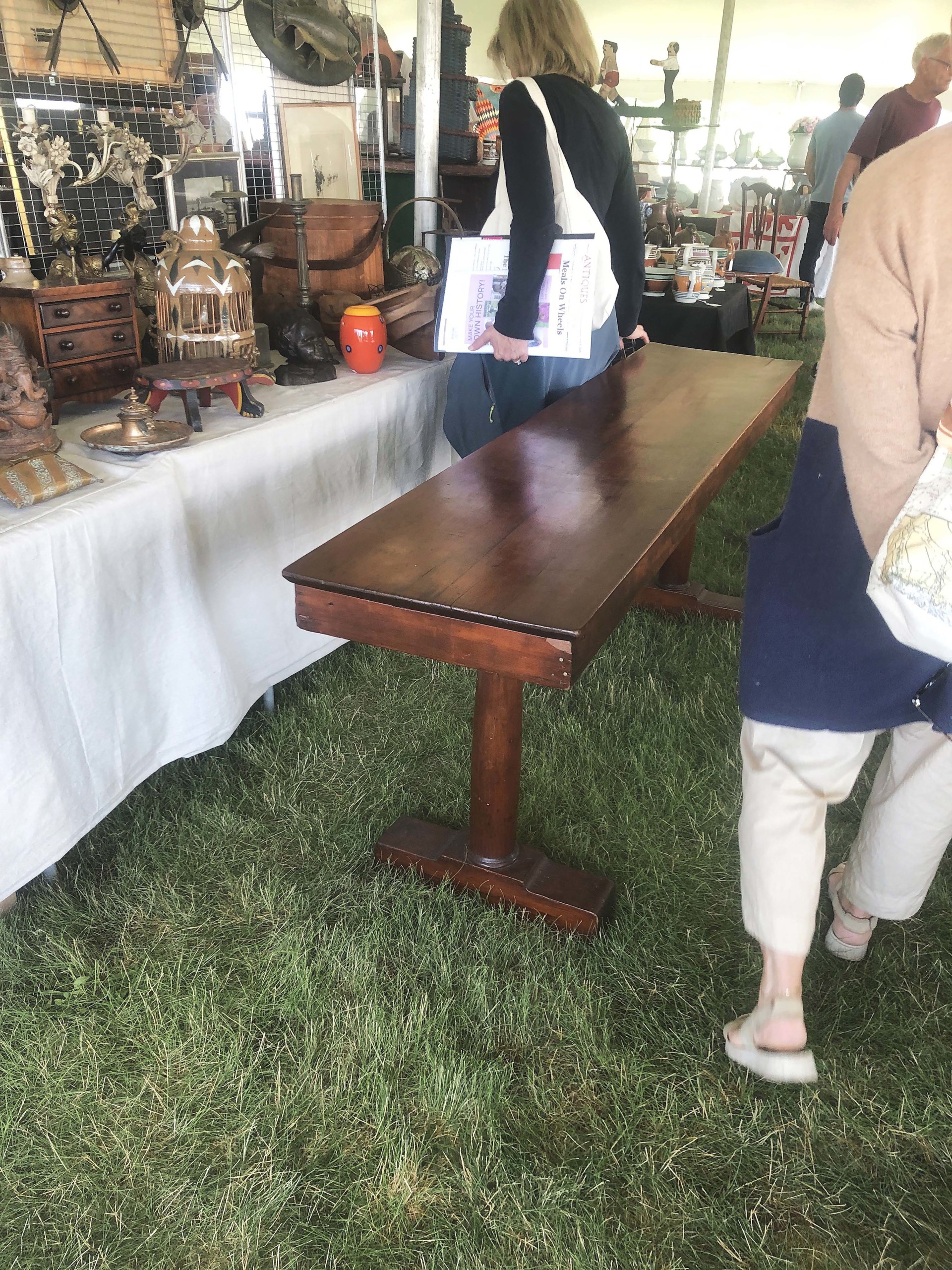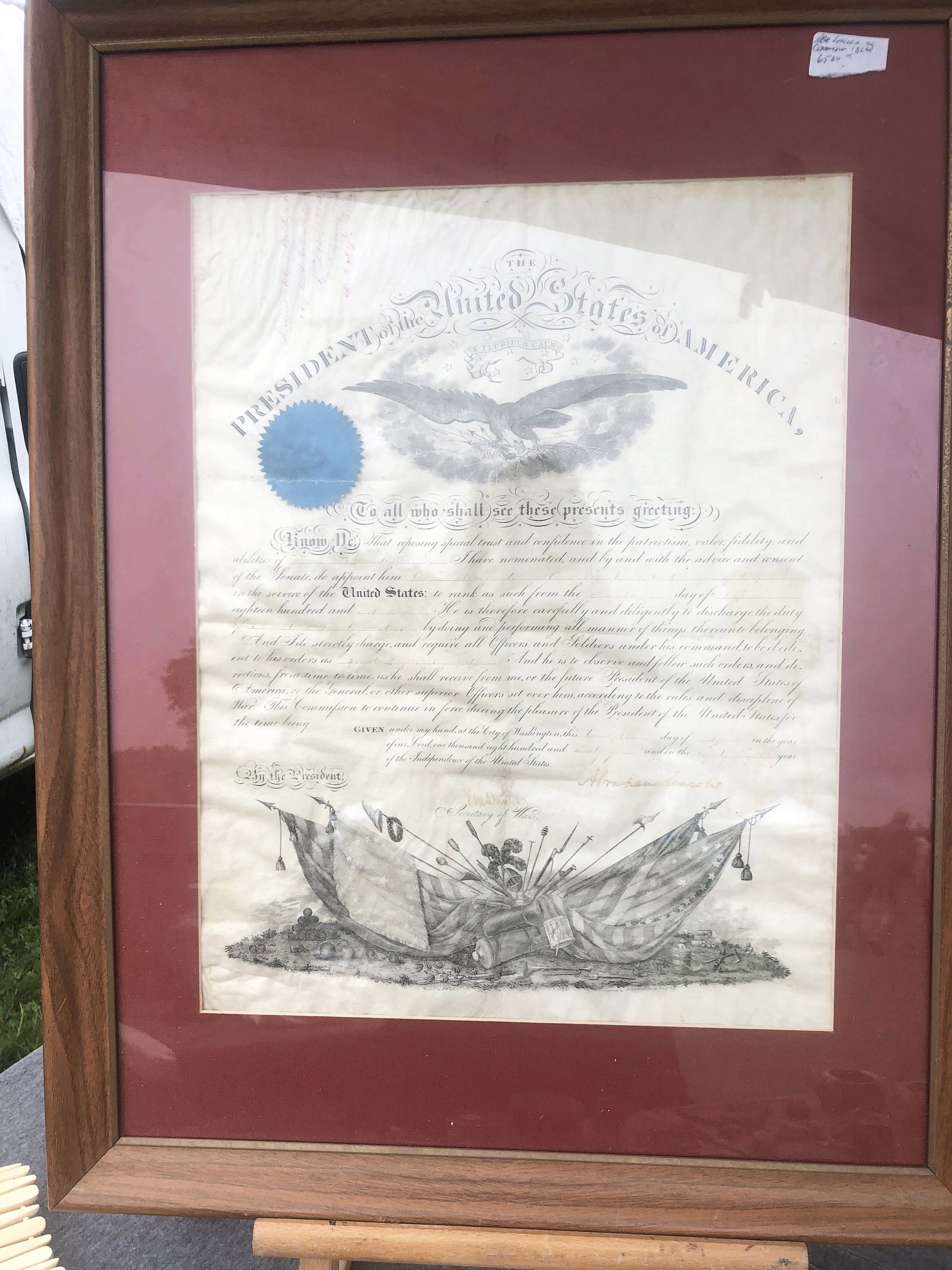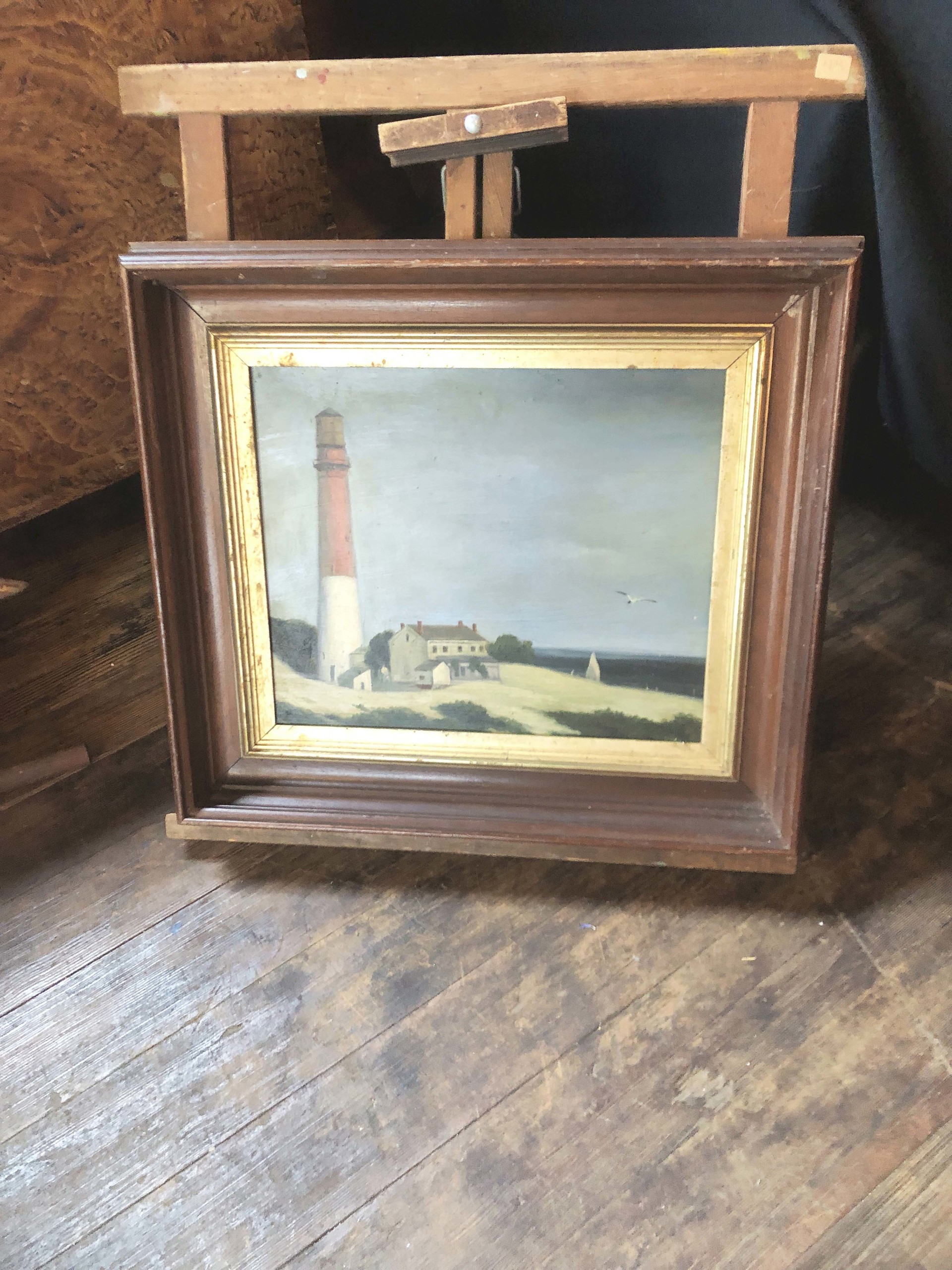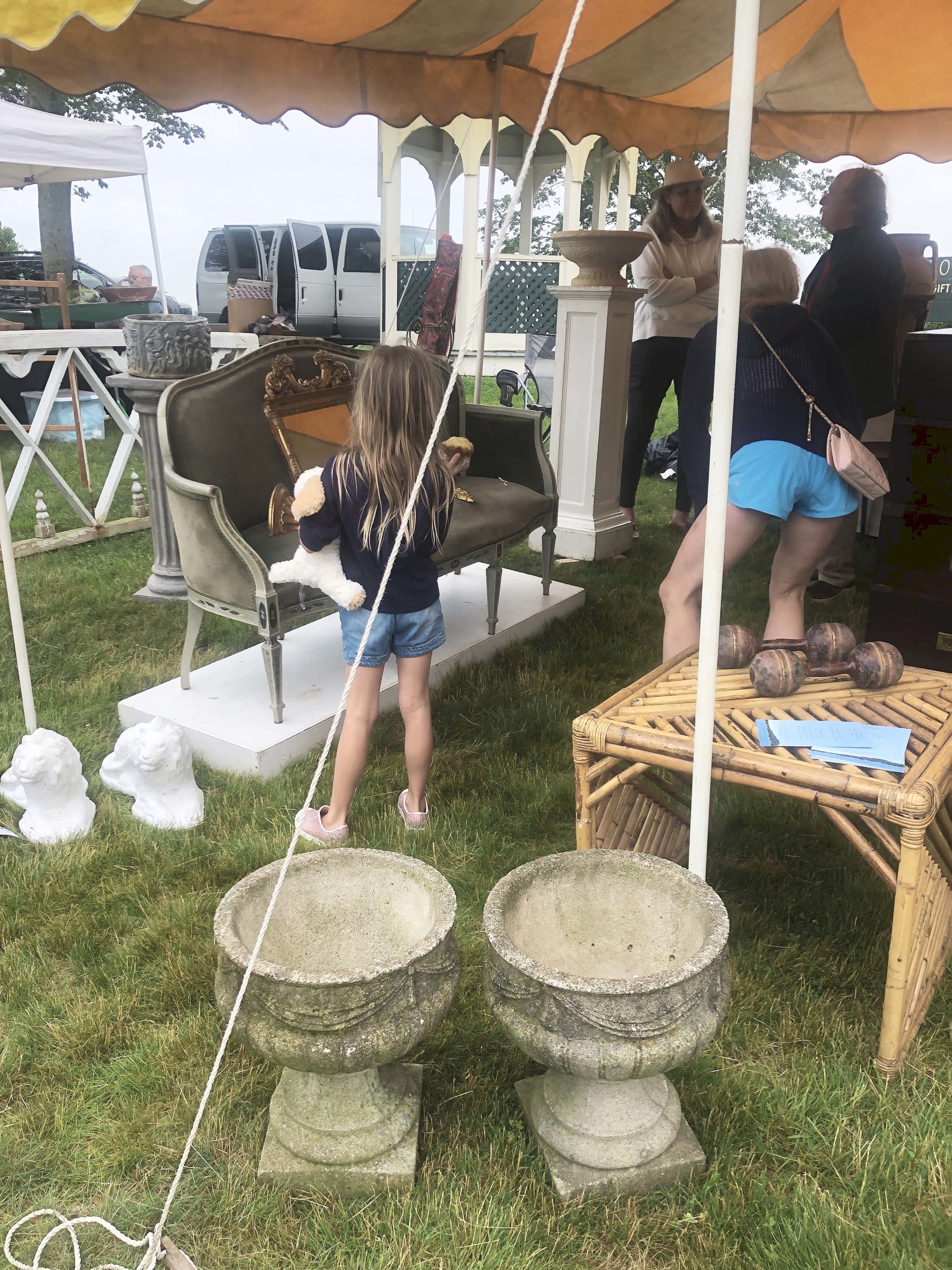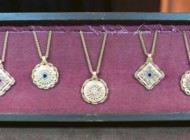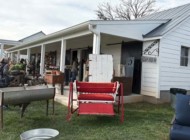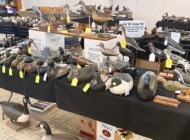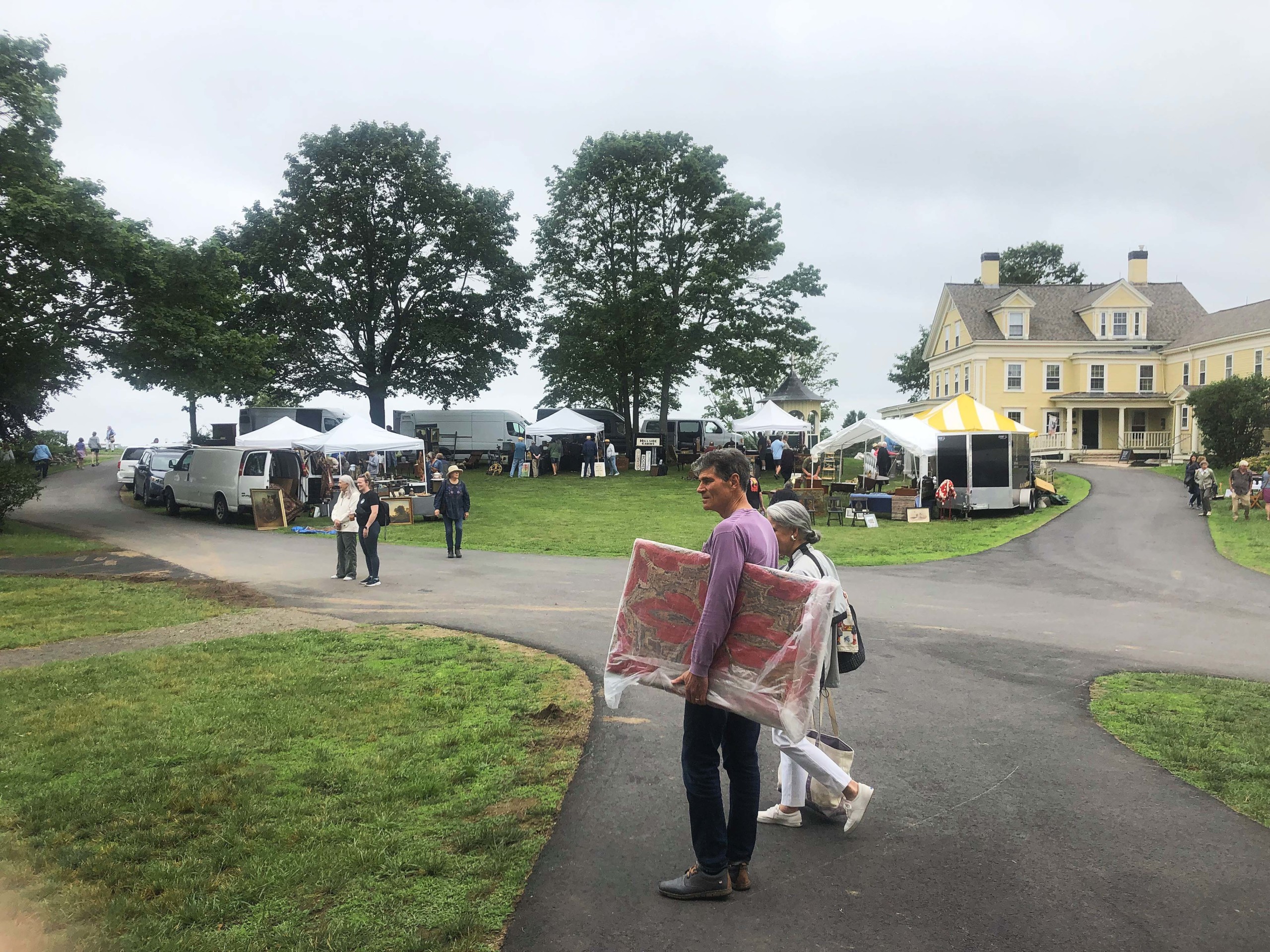
Estuaries are beyond those trees, separating the Laudholm campus from the Atlantic Ocean and beach a short distance away. The Visitor Center is the large building on the right.
Review & Onsite Photos by Madelia Hickman Ring
WELLS, MAINE — It’s hard to imagine a more picturesque venue to celebrate the material cultural of the American past than at Laudholm Farm at the Wells National Estuarine Research Reserve. According to the property’s website, it was formerly the summer home of George C. Lord (1823-1893), president of the Boston & Maine Railroad, who had grown up in nearby Kennebunk, Maine. But the property — then called “Farm Hill” — has an even earlier history: it was first occupied in 1643 by Town of Wells founder, Henry Boade, before he sold it to William Symonds, a land speculator who worked it before it was burned during King Philip’s War, in 1676. Nathaniel Clark, Jr, occupied the property in 1717 and, with his family, ran it for 150 years before it passed into the hands of the Lord family.
Lord’s son Robert had agricultural interests and turned the property into a dairy farm using imported purebred Guernsey cows; by 1908, the property was renamed “Laudholm Farm” and, under the direction of Robert’s brother, Charles, and Charles’ son, George, the farm became the largest and most progressive saltwater farms in York County, supplying milk, cream, butter, eggs, broiler and roasting chickens to locals as well as weekly shipments to Boston. By 1978, the fate of Laudholm farm concerned local citizens, who in 1982 formed to nonprofit Laudholm Trust. Now on the National Register of Historic Places, the Laudholm campus comprises a visitor center, barn with auditorium and resource library, a teaching lab and the Maine Coastal Ecology Center and is devoted to education, conservation and research…and special events, such as the annual Wells Antiques Show, which took place on Sunday, June 29.
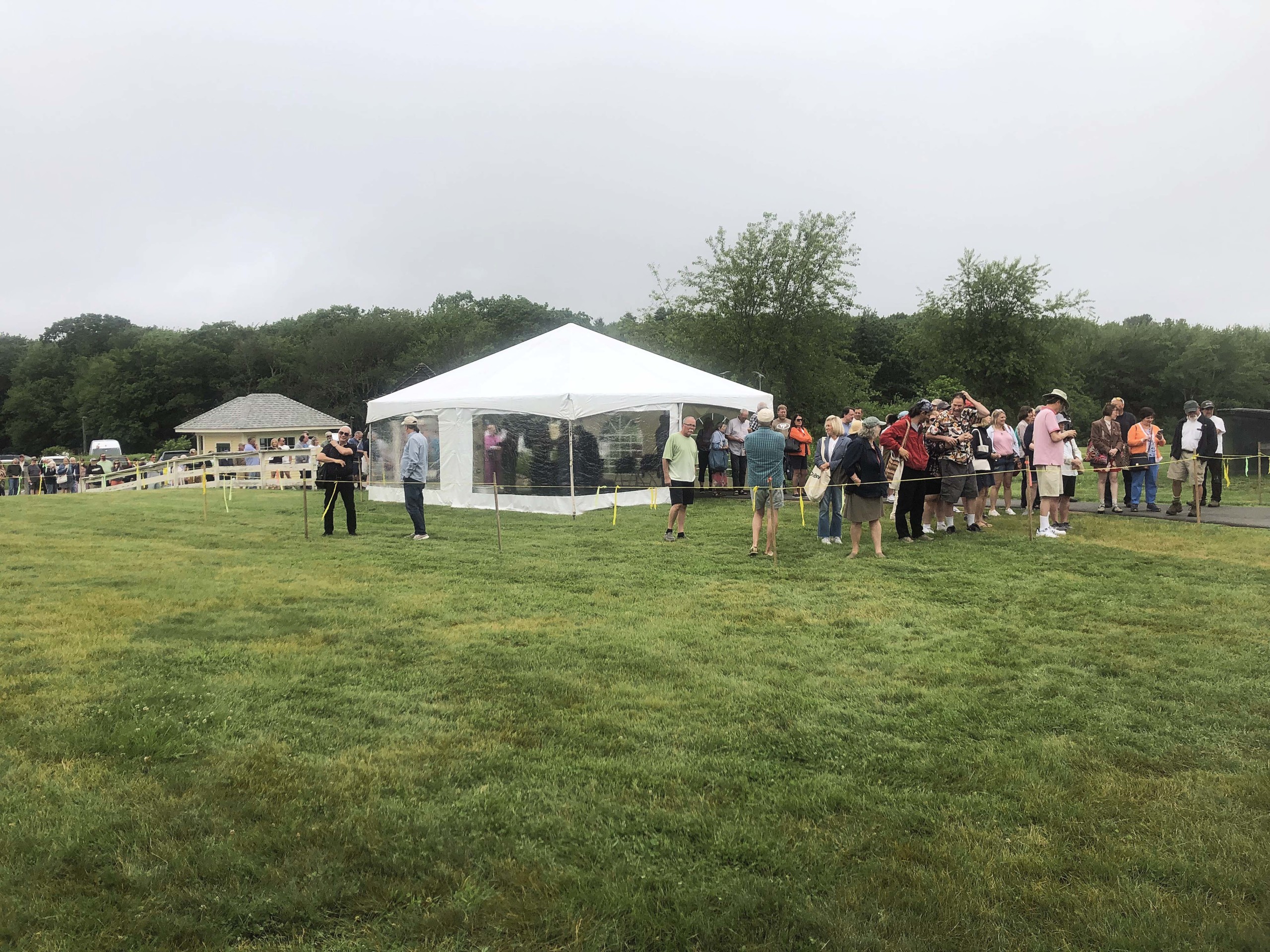
Shoppers waiting until the show opened; the line stretched back towards the parking lot, past the left side of this photo.
Goosefare Antiques & Promotions has run the show continuously since its inception; it is now in its 24th year. The only building available for special events — including the antiques show — is the barn, but John and Elizabeth DeSimone pitch large tents to accommodate the more than 50 dealers who come from both near and far for the event, which John calls “our biggest show.”
Wet weather Saturday made for a damp field to set up in, but dealers came prepared for a cool, misty Sunday morning, with outerwear and waterproof boots. A few hundred people waited patiently for the show to open and the marine layer quickly burned off, leaving a glorious — if humid — day.
The upper level of the barn was resplendent with twinkle lights from the exposed beams and housed a baker’s dozen booths. Jim Lefurgy and Judy Waner have been doing the show for a decade; she showed us a set of two framed Chinese bookplates in a dialect no longer used. She had found them in the Los Angeles area a few years ago.
Harry Hepburn had several clocks on offer, including a tall case clock with a dial signed by Paul Rogers of North Berwick, Maine, and a banjo clock from Waltham, Mass. For those whose preferences ran to furniture, a set of eight birdcage Windsor side chairs with a rare shaped seat were one stand-out group.
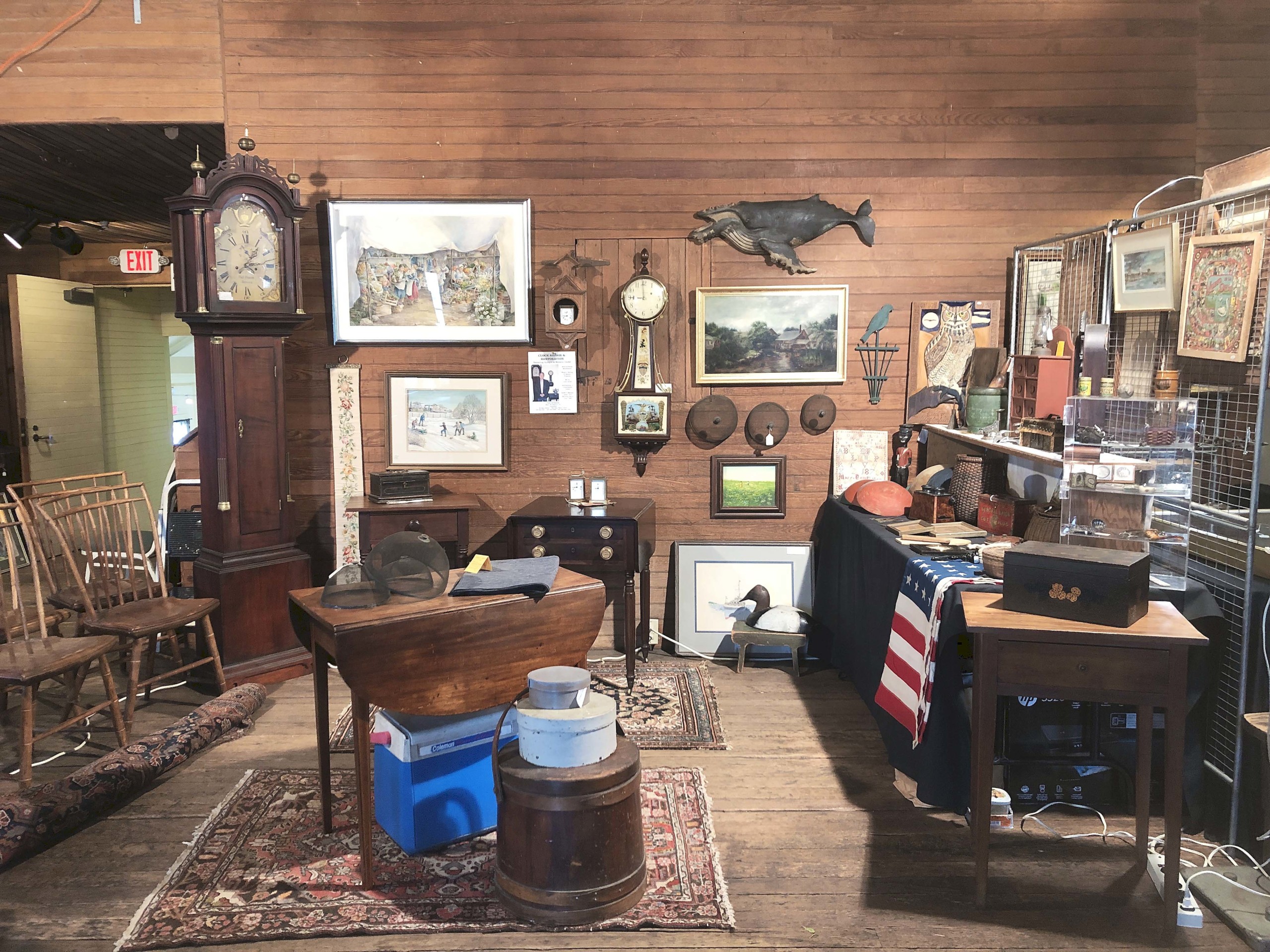
Harry W. Hepburn III, Harrison, Maine.
Peter Murphy was back for the first time after nearly 20 years away. A set of 1871 framed alphabets with a temperance theme was among his favorite pieces; they had been done by Edward Carsell in New York City and were dated 1871.
Drew Epstein and Sandy Jacobs had the corner booth next to Murphy. Epstein has been a photographer most of his life — he’s an attorney in his “day job” — and was selling, alongside the jewelry Jacobs has as her stock in trade, several frame photographs, including ones he had taken himself.
Martin Ferrick brought a number of landscapes by Kennebunkport, Maine, artist, Louis D. Norton (1868-1940). These showed well with the case pieces he brought with him from Lincolnville, Maine.
Ted and Jennifer Fuehr were participating in the show for the first time and they were thrilled to be in the barn. Though the dealers are based in Shawnee Mission, Kan., the couple have owned a house in Hampton, N.H., where they summer and which provides an ideal home base for all the shows they do over the summer. Among their weathervanes, eagle wall plaques and Navajo jewelry, mochaware and hooked rugs stood out.
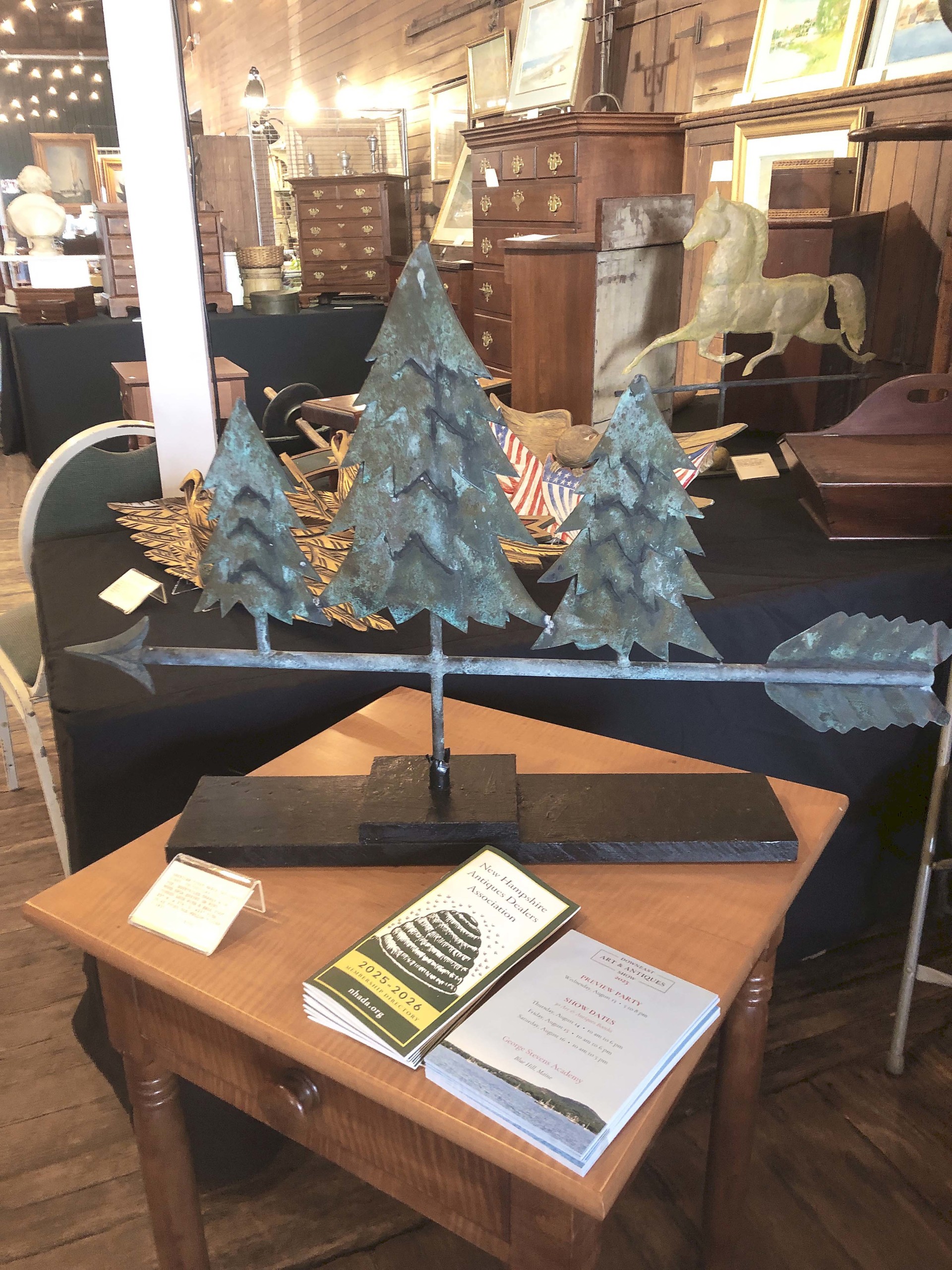
Ted Fuehr said this full-bodied copper evergreen tree-form weathervane had been found in Maine; he thought it dated to the 1930s or 40s. American Spirit Antiques, Shawnee Mission, Kan.
Across the aisle from the Fuehrs, was Nancy Douglass, who is Willow Springs Perennial. While a selection of nautical paintings —including one of a lighthouse — gave shoppers ample choice, she also had porcelain, sailor’s valentines, painted boxes in a good variety of sizes, a fireman’s helmet and horn weathervane and a penny hooked rug that was mounted to an A-frame. According to the faded label on the back, it had been made in Bennington, Vt., by Eileen M. Briggs.
One of the areas of the barn that the show spread out into was the step-down milking parlor, where a half-dozen dealers laid out their wares. Deirdre O’Callaghan, who is Partridge Hill Antiques, had a good selection of framed pieces, including a limited edition lithograph titled “Cove at Dusk,” by John Muench.
Mike Hingston, across from O’Callaghan, had last exhibited at the NHADA show in Concord, N.H., and he brought art and silver he had not showed there. Among his stand-out pieces was a fall landscape by Robert Scott Lovejoy (American, 1885-1975) titled “Hessian Hill,” which he’d purchased during the pandemic.
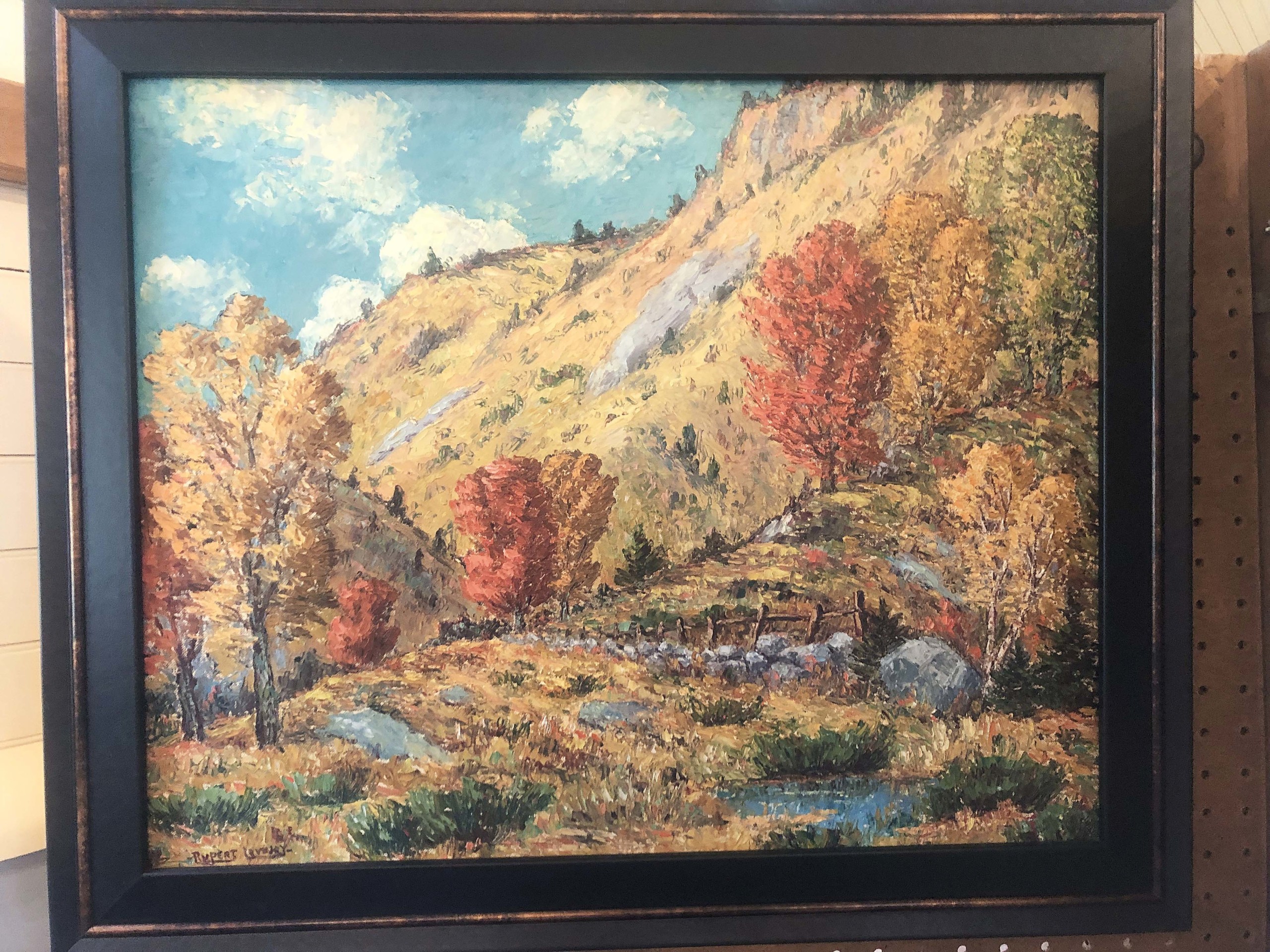
Mike Hingston purchased “Hessian Hill,” an oil on board by Rupert Scott Lovejoy during the pandemic. Michael Hingston Antiques, Manchester, N.H.
David Weidner and Jared Cilley, proprietors of Dark Flowers Antiques, brought the Zsolnay iridescent glass pieces and hand-painted pottery they usually have, but two items were special: the first was an Art Deco design vase by Émile Balon, Blois, France, the other was a tall cylindrical Limoges pottery vase with Queen Anne’s Lace decoration that was signed and dated by the maker: “McDowell, 1908.”
Karen Redinger and Jack Papadinis are from West Simsbury, Conn., and they were showing at Wells for the first time. Redinger specializes in textiles and related antiques while Papadinis — who sells under the business name Jack Pap Antiques — has a special fondness for the decorative arts of the Arts and Crafts, Art Nouveau and Art Deco periods. Among Redinger’s selection of linens, boxes, beadwork and miniature baskets, she had a selection of shoe-form pincushions she’d acquired from a Connecticut collection. Two tables showed off his selection of leaded glass and bronze lamps and art pottery.
In the tent by the barn, Ron and Joyce Bassin had a selection of Grenfell Mission mats — one of their areas of expertise — as well as a small bronze model of a fox by PJ Mene that was making its show debut. A set of Midcentury Modern painted cannisters, signed “Ransburg” and made in Indianapolis, Ind., for flour, sugar, coffee and tea, were also recent acquisitions, picked up on a road trip. “They’re not really our thing…but very fun,” Bassin said.
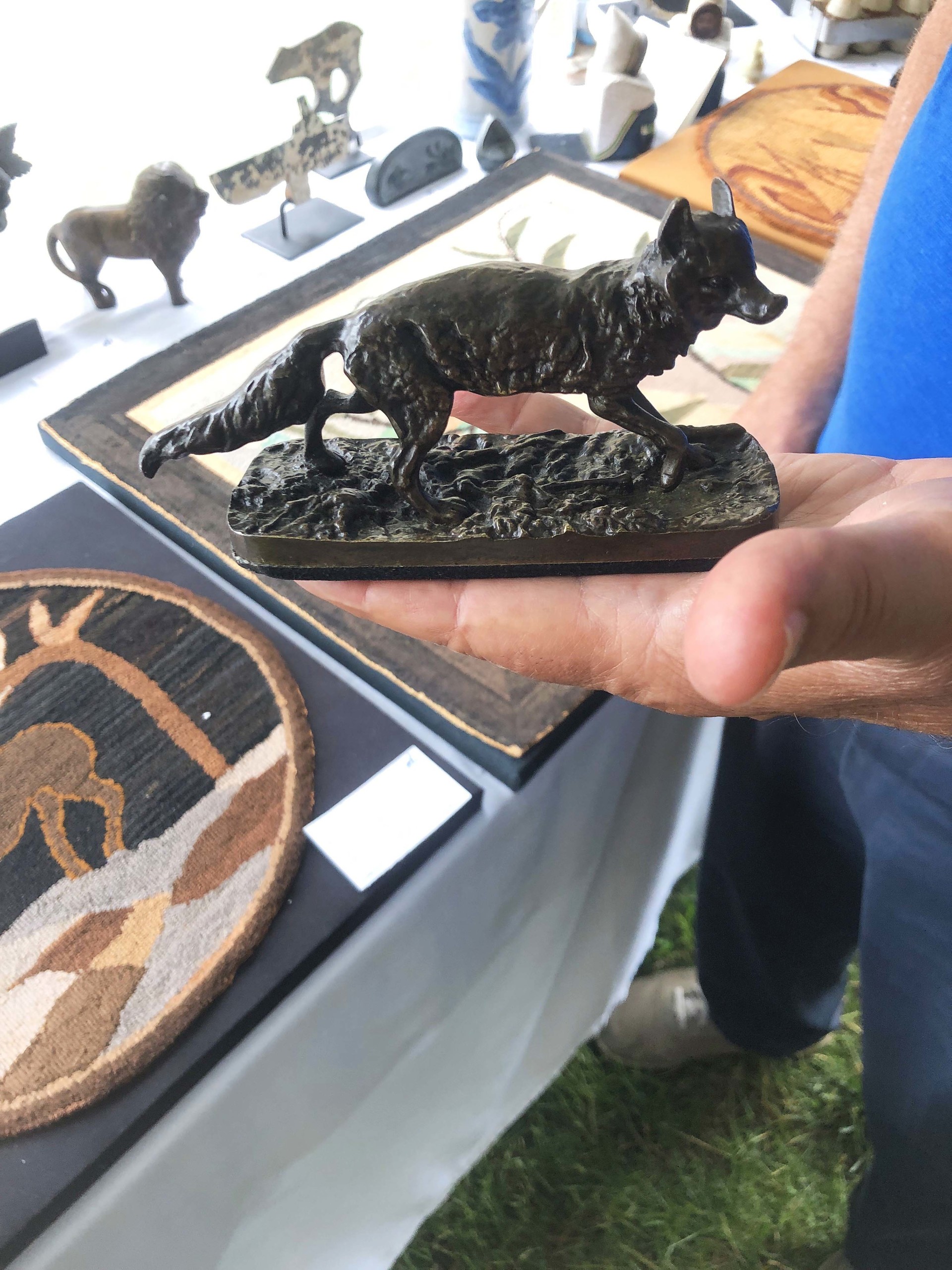
This small bronze model of a fox by PJ Mêne, was a recent acquisition by Ron & Joyce Bassin, A Bird in Hand Antiques, Florham, Park, N.J.
In the same tent as the Bassins, Brett Cabral showed us a whimsical pottery teapot made by Eilene Sky and a selection of miniature Blue Hill Pottery pieces signed by Mark Bell. For pewter enthusiasts, he had a 12-piece miniature train set by Schmid.
Painted furniture and smalls are the usual fare Dennis and Valerie Bakoledis bring to their shows and this event did not disappoint, with a painted dressing table, large roulette wheel, stoneware and redware, baskets, hooked rugs and, a perennial favorite with the Rhinebeck, N.Y., dealers, a running horse weathervane.
The Bakoledis’s neighbor was Linda Perkins, who had several special things. Among these was a very early “topsy-turvy” doll, two mid Nineteenth Century photographs, a selection of baskets and a selection of old baby’s shoes.
Don Heller’s booth was in the direct path leading up from the show’s main gate. Furniture in both wood and cast iron shared space with a case of nautical antiques, Chinese export porcelain, ship paintings, a blackware olla made by Mata Ortiz he described as “monumental” and a large clamshell on a white-painted dressing table.
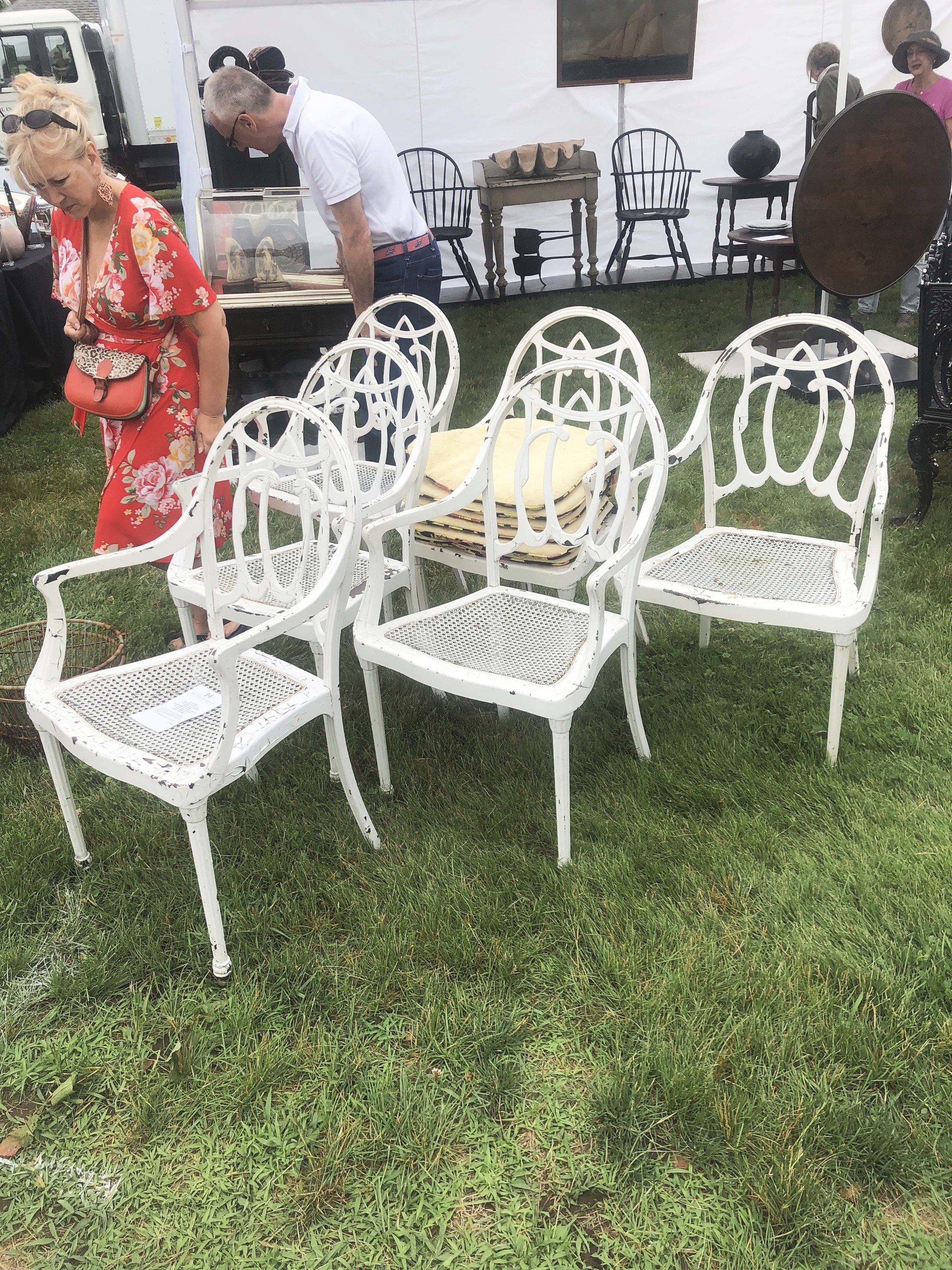
This set of six Art Nouveau style cast iron and aluminum armchairs were made by the Doehler Metal Furniture Company in New York City. Heller-Washam Antiques, Portland, Maine.
In the lawn that faced the barn, Hilary and Paulette Nolan were having a good show even before it officially opened, selling an early Connecticut armchair and portrait to other dealers.
Michellle Genereux, in the center of one of the tents on the front lawn, had wrapped up several sales by midday, including a three-dimensional ship picture, a framed map of Wells, a metal and glass table and a cast-iron planter.
Tom Jewett and Butch Berdan were kitty-corner from Genereux, in the same tent, and had glowing words to say after the event wrapped.
“We had our best Wells show ever. We sold a wide range across the board: a collection of 14 butter stamps, a painted half hull, a painted basket, a carved wooden swan, a pair of garden urns, a country stool in green and some holiday,” Jewett told Antiques and The Arts Weekly.
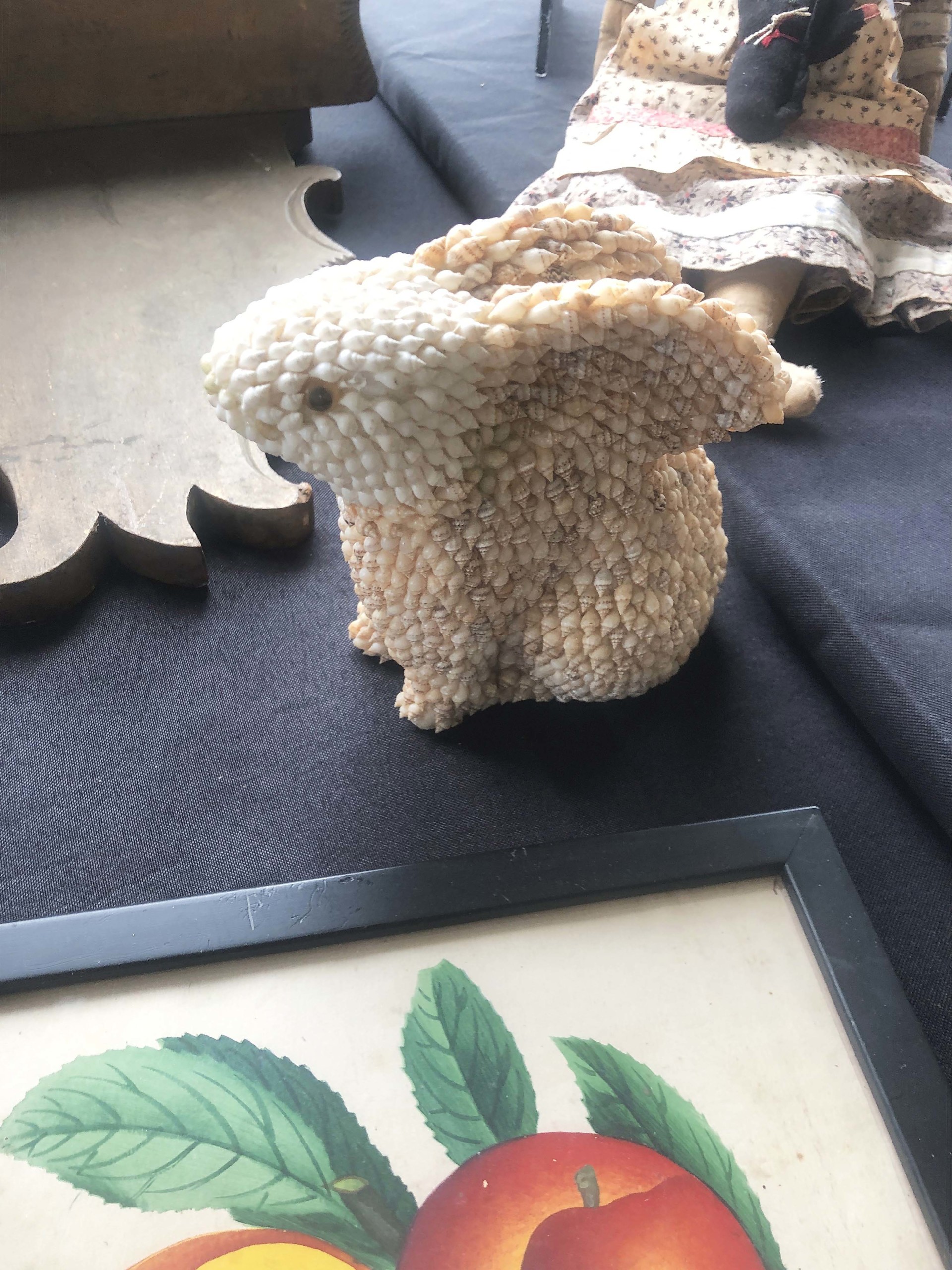
This shellwork rabbit, with Tom Jewett and Butch Berdan, could not have been more than a few inches tall but it exuded charm beyond its size. Newcastle, Maine.
In the next tent, Derik Pulito said he’d sold a painted dressing table that had been taken out of his booth. An exceptional offering was a pair of fan-back Windsor side chairs, stamped by Berick Green of Lisbon, Conn., and an early Pennsylvania starburst quilt.
Pulito’s neighbor Christopher Settle told us he had largely retired from doing shows and what he had on hand was stuff from his attic. Toys were a large category, with toy pistols and a set of tanks among the selection he brought to the show.
Next to Settle, Mike and Lucinda Seward had a large variety that included early silver, Steiff stuffed animals, a Japanese woodblock print, some Native American weavings, a charming portrait of a young woman in a green dress they’d discovered in Newton, Mass., a small sampler from Granby, Vt., and a group of two carved birds from the Nineteenth Century. Standing out from all else were two black-and-white photographs, framed together, that had a decidedly modern feel.
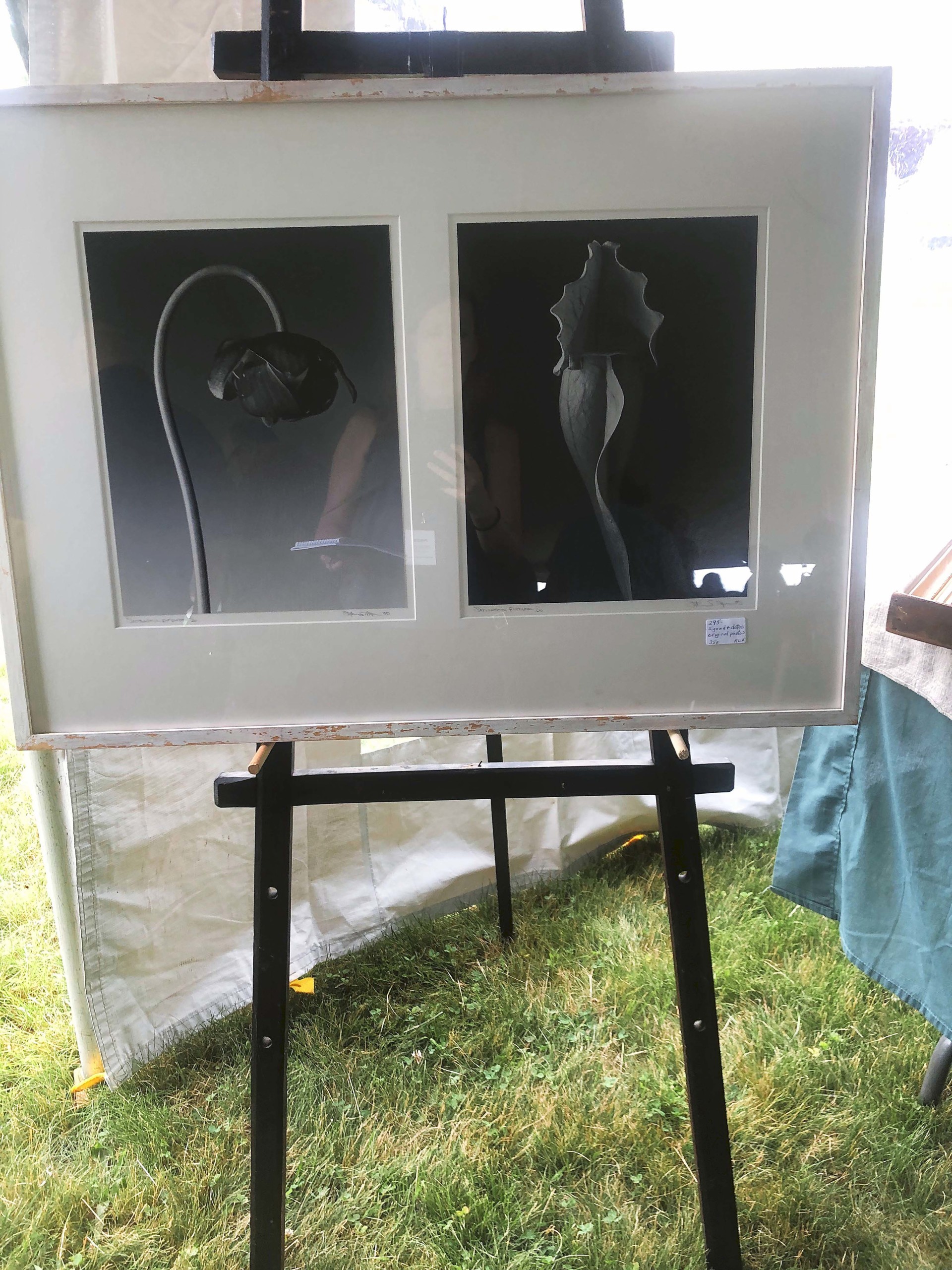
These black and white photographs seemed positively modern compared with the rest of the offerings at the show. Michael and Lucinda Seward, Pittsford, Vt.
Lobster is Maine’s state crustacean, so they are commonly associated with the area; several dealers brought lobster-themed objects to appeal to local buyers. Among these were a pair of salt and pepper shakers (Melissa Alden Antiques, Portsmouth, N.H.); a two-piece lobster-claw salad serving set made in Germany in the 1930s (P.D. Murphy Antiques, Bath, Maine); a metal lobster sculpture (Robert T. Foley, Gray, Maine); and a sign that used lobsters to spell out the word “LOBSTER” (Perkins & Menson Antiques, Ashby, Mass.).
Goosefare has a robust lineup of upcoming events, including the 57th New London Historical Society antiques show and sale in New London, N.H. (July 26), Antiques on the Mashpee Commons’ Antiques Show & Sale in Mashpee, Mass. (August 9) and the Fifth Antiques at the Academy antiques show and sale, in the Founders Gym on the campus of the Cape Cod Academy in Osterville, Mass. (August 23).
For information, www.goosefareantiques.com.
